Fujitsu Client Computing WB0038 LIFEBOOK T SERIES with WM3945ABG 11ABG WLAN & BT User Manual T Series
Fujitsu Limited LIFEBOOK T SERIES with WM3945ABG 11ABG WLAN & BT T Series
Contents
- 1. App I1 User Manual part 1
- 2. App I2 User Manual Part 2
- 3. App I1 User Manual Part 1
- 4. App I2 User Manual part 2
App I1 User Manual part 1
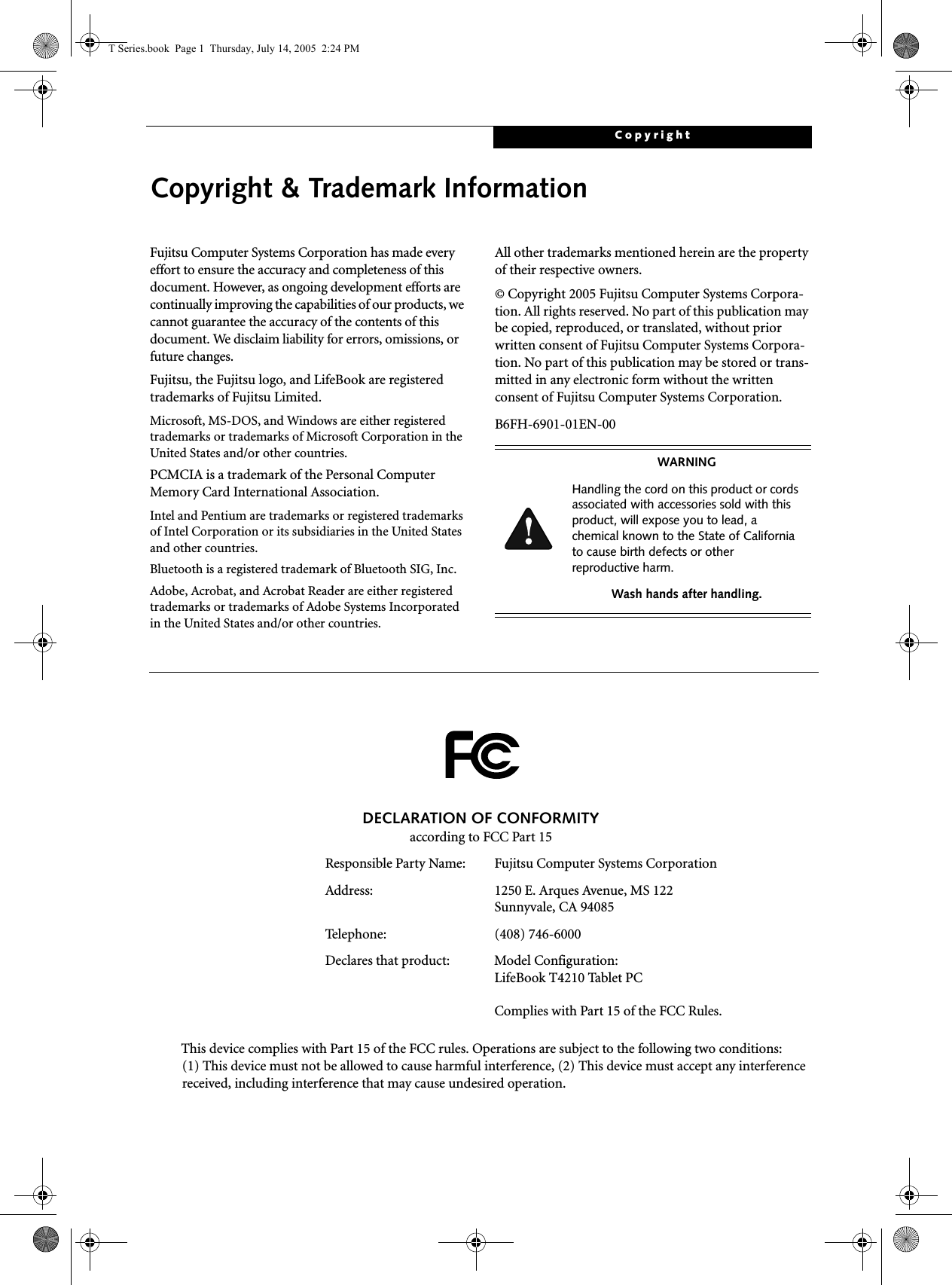
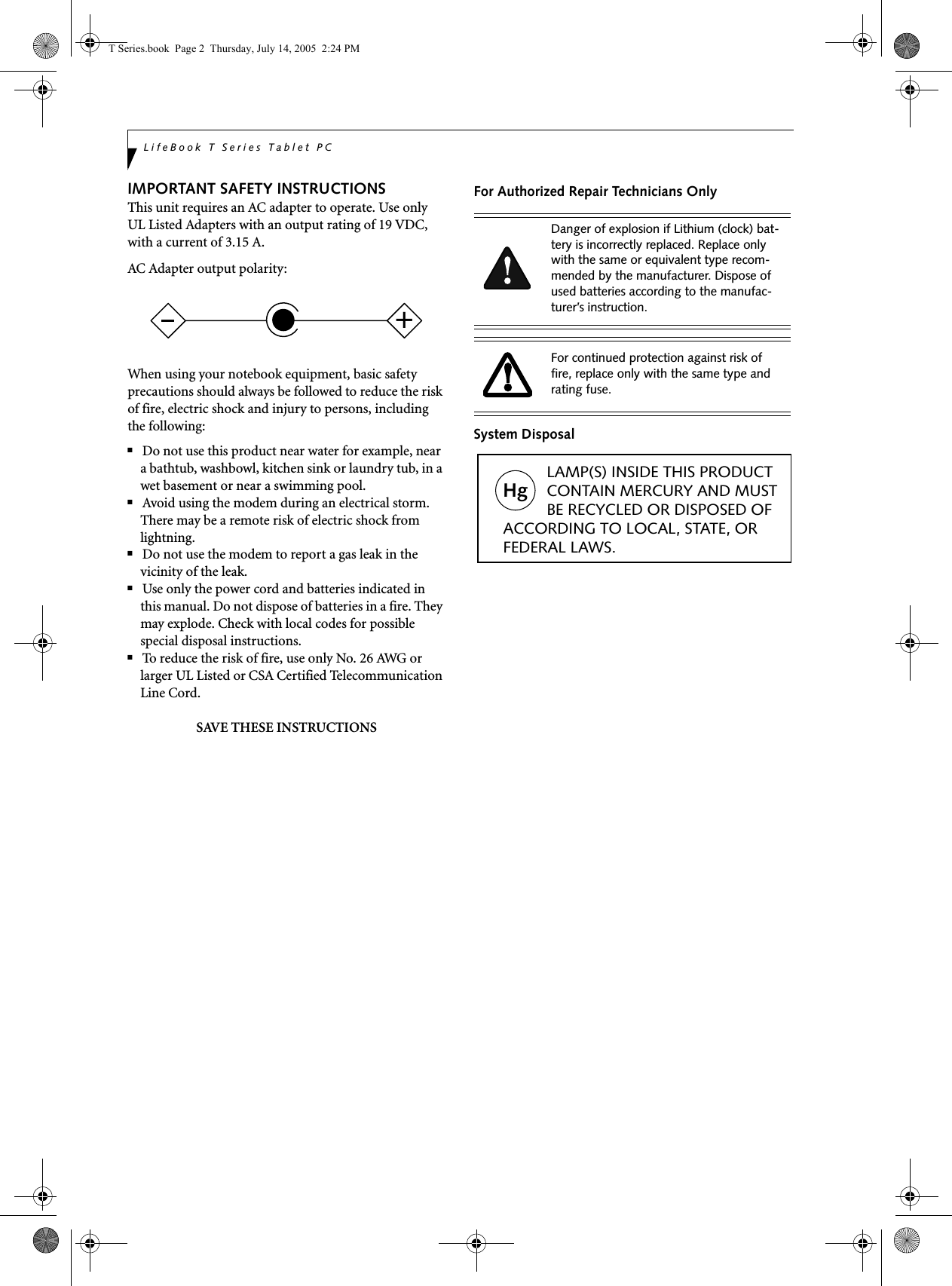

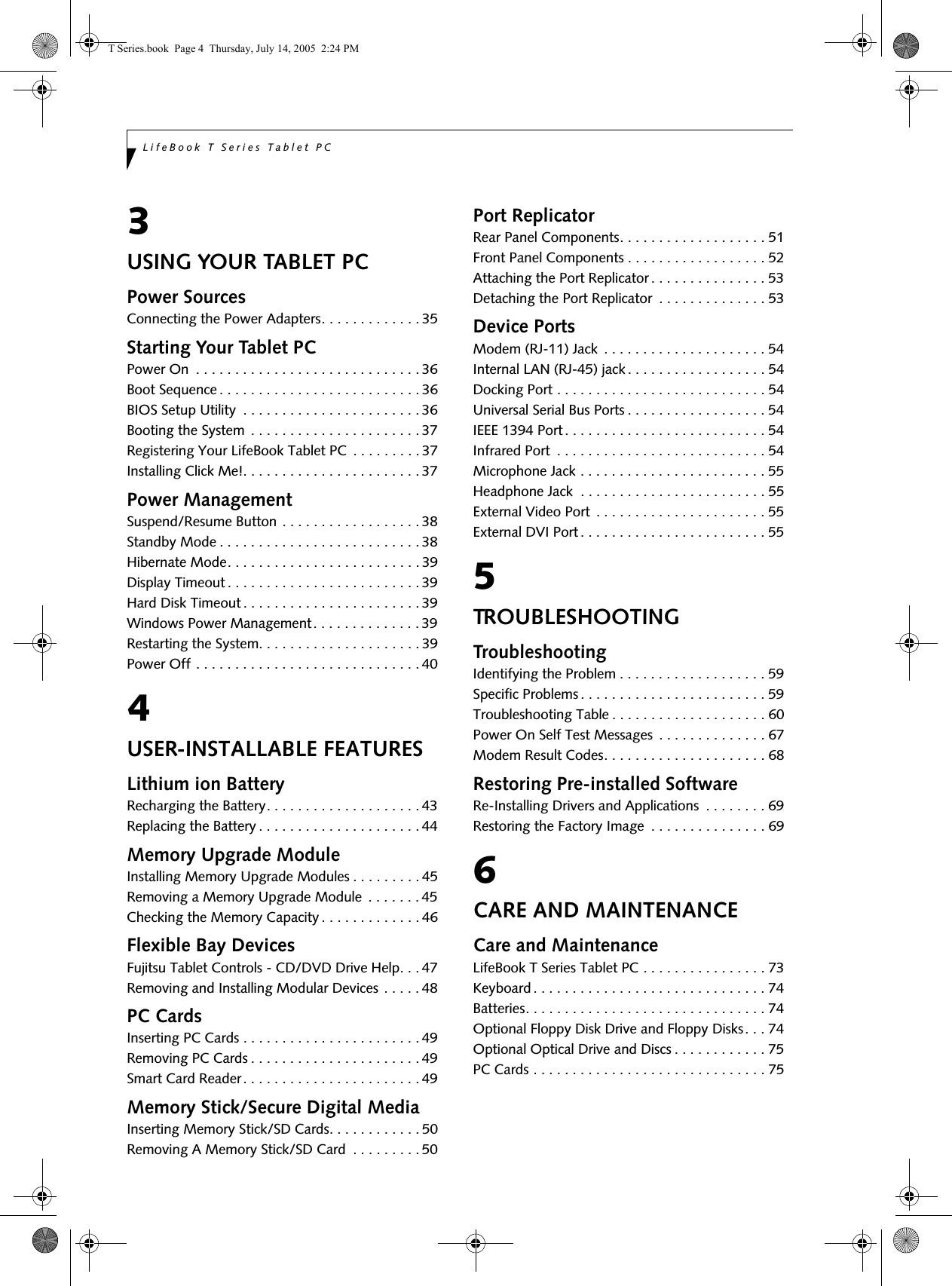


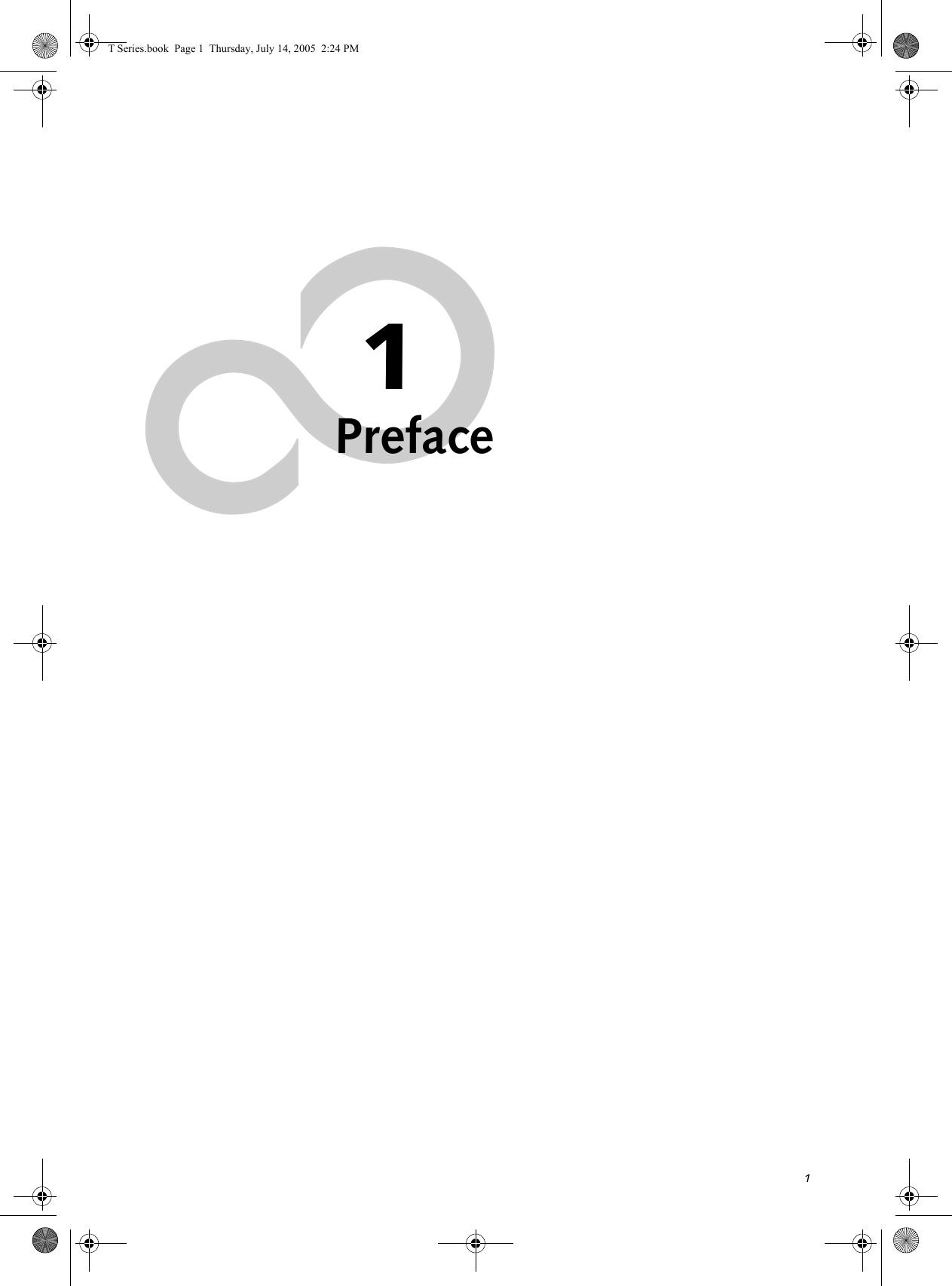

![3PrefacePrefaceABOUT THIS GUIDEThe LifeBook® T Series Tablet PC from Fujitsu Computer Systems Corporation is a powerful convert-ible computer. It can be used either as a standard note-book using keyboard input, or in tablet configuration using pen input. It is powered by an Intel® micropro-cessor, has a built-in color display with an active digi-tizer, and brings the computing power of desktop personal computers (PCs) to a portable and versatile environment.This manual explains how to operate your LifeBook T Series Tablet PC’s hardware and built-in system soft-ware. Your LifeBook T Series Tablet PC comes with Windows® XP Tablet PC Edition 2005 pre-installed.Your LifeBook T Series Tablet PC is a completely self-contained unit with an active-matrix (TFT) color LCD display. The display has a wide viewing angle and can be used indoors or outdoors. The tablet has a powerful interface that enables it to support a variety of optional features.Conventions Used in the GuideKeyboard keys appear in brackets. Example: [Fn], [F1], [Esc], [Enter] and [Ctl].Pages with additional information about a specific topic are cross-referenced within the text.Example: (See page xx.)On screen buttons or menu items appear in bold.Example: Click OK to restart your Tablet PC.DOS commands you enter appear in Courier type. Example: Shutdown the computer?FUJITSU CONTACT INFORMATIONService and SupportYou can contact Fujitsu Computer Systems Service and Support the following ways:■Toll free: 1-800-8Fujitsu (1-800-838-5487)■Fax: 1-408-764-2724 ■E-mail: 8fujitsu@us.fujitsu.com ■Web site: http://www.computers.us.fujitsu.com/supportBefore you place the call, you should have the following information ready so that the customer support representative can provide you with the fastest possible solution:■Product name■Product configuration number■Product serial number■Purchase date■Conditions under which the problem occurred■Any error messages that have occurred■Type of device connected, if anyFujitsu OnlineYou can go directly to the online Fujitsu Product catalog for your Tablet PC. Go to Start -> Fujitsu WebLinks -> Pen Accessories Web site.You can also reach Fujitsu Service and Support online by going to Start -> Fujitsu WebLinks -> Fujitsu Service and Support.WARRANTYYour LifeBook T Series Tablet PC is backed by an Inter-national Limited Warranty and includes toll-free tech-nical support. Check the service kit that came with yourTablet PC for warranty terms and conditions.The information icon highlights information that will enhance your understanding of the subject material.The caution icon highlights information that is important to the safe operation of your computer, or to the integrity of your files. Please read all caution information carefully.The warning icon warns you about possible hazards that can occur to you, your system, or your files. Please read all warning information carefully.You must have an active internet connection to use the online URL links.T Series.book Page 3 Thursday, July 14, 2005 2:24 PM](https://usermanual.wiki/Fujitsu-Client-Computing/WB0038.App-I1-User-Manual-part-1/User-Guide-639920-Page-9.png)
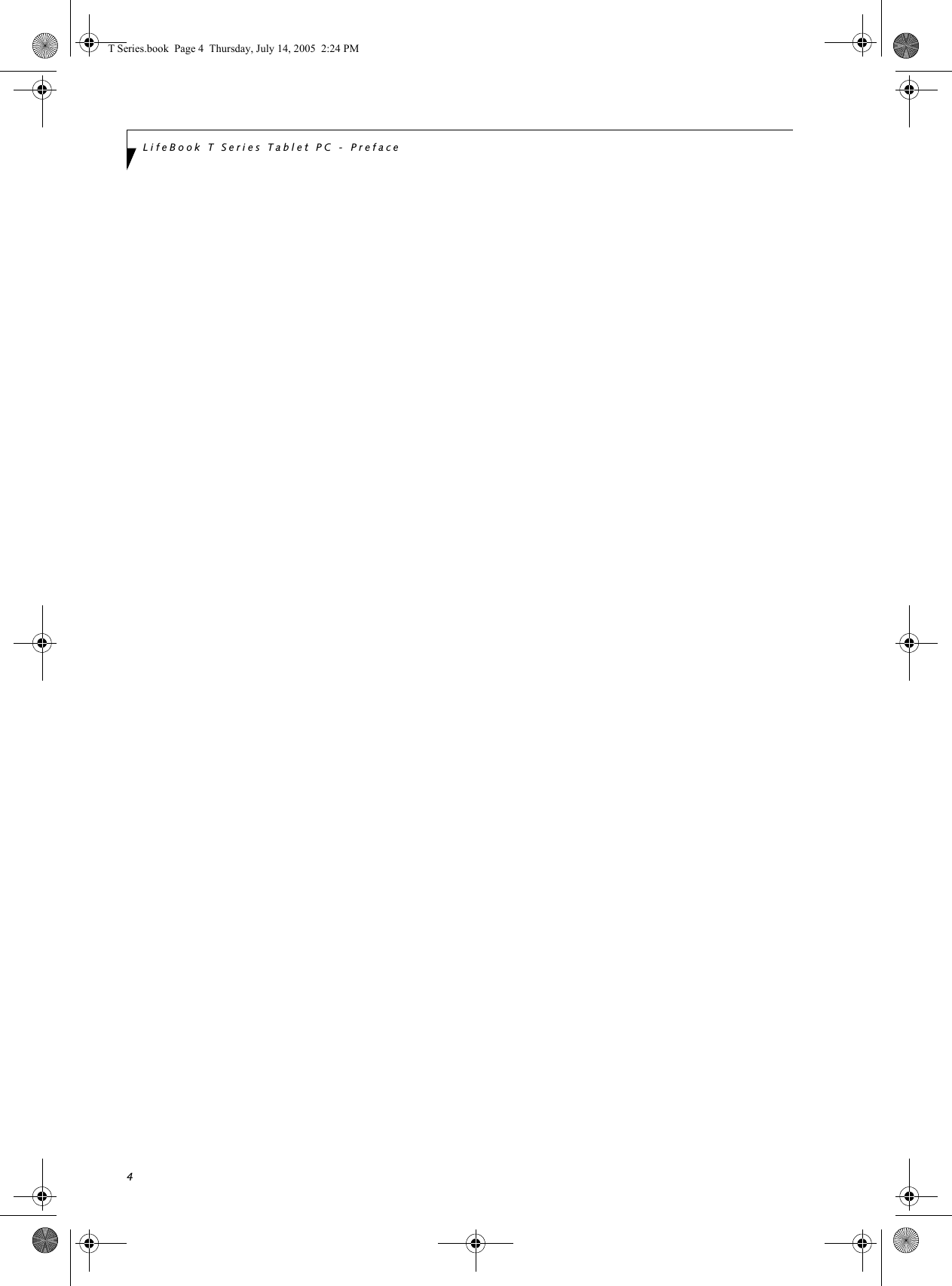
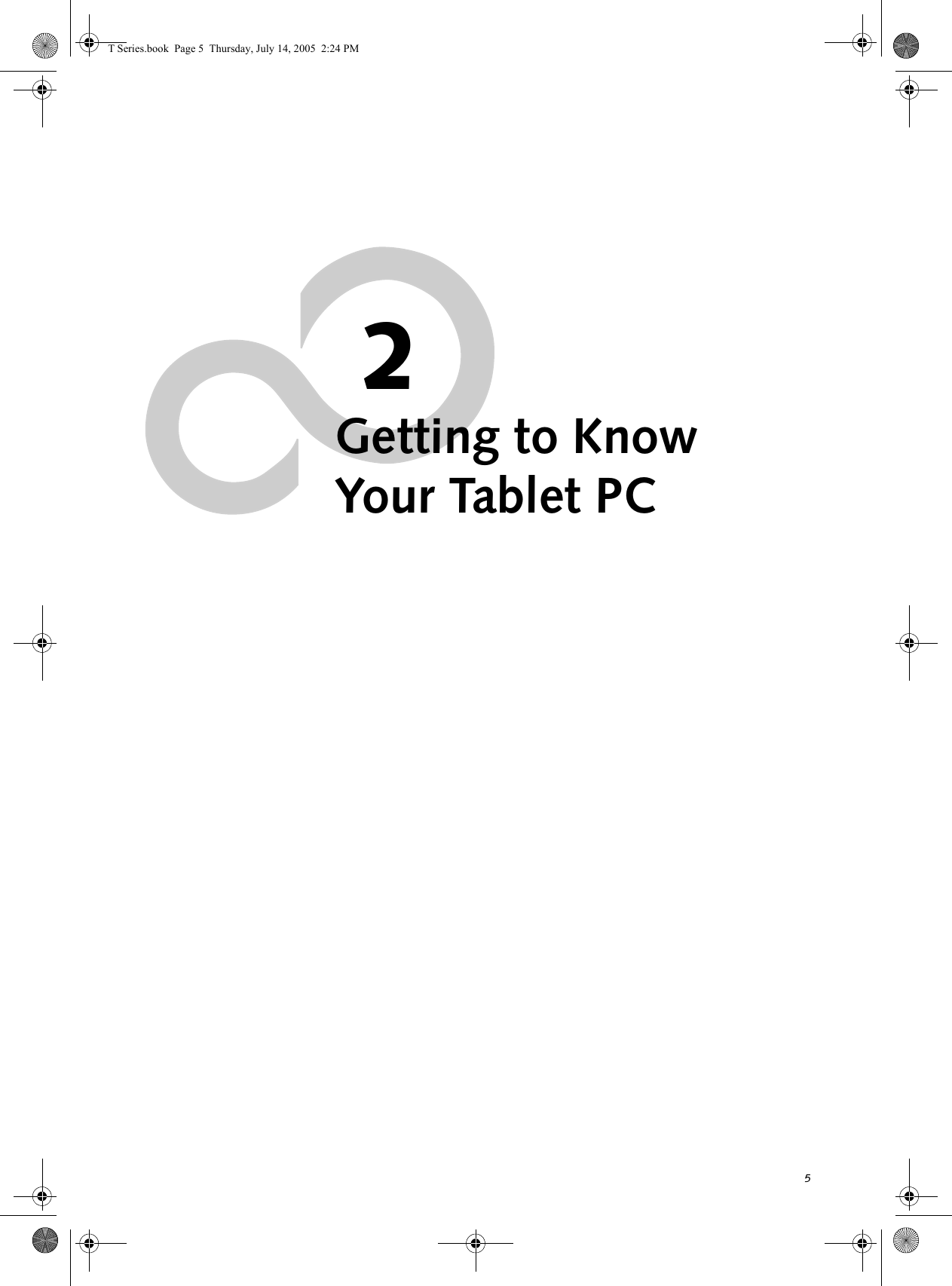
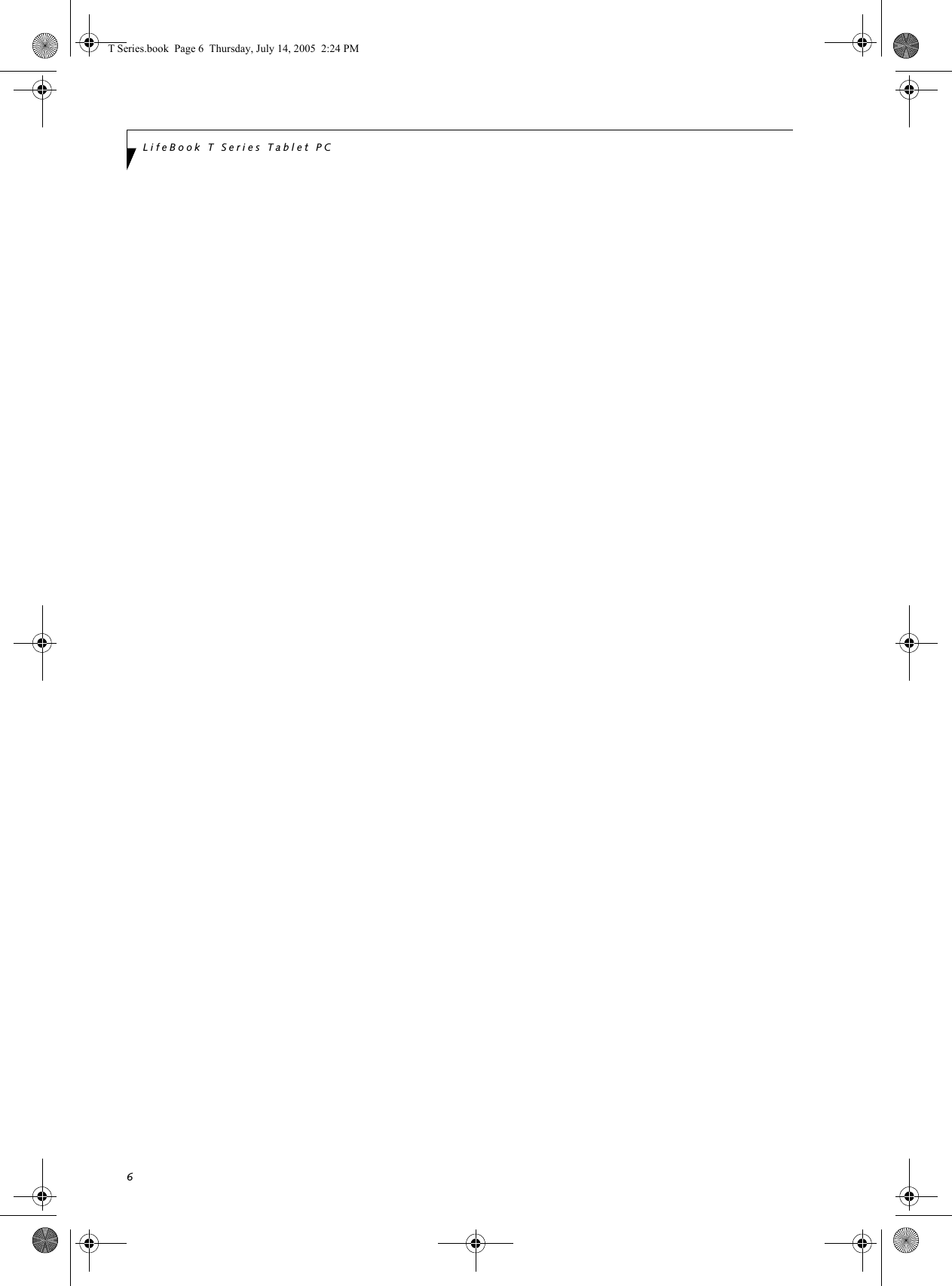
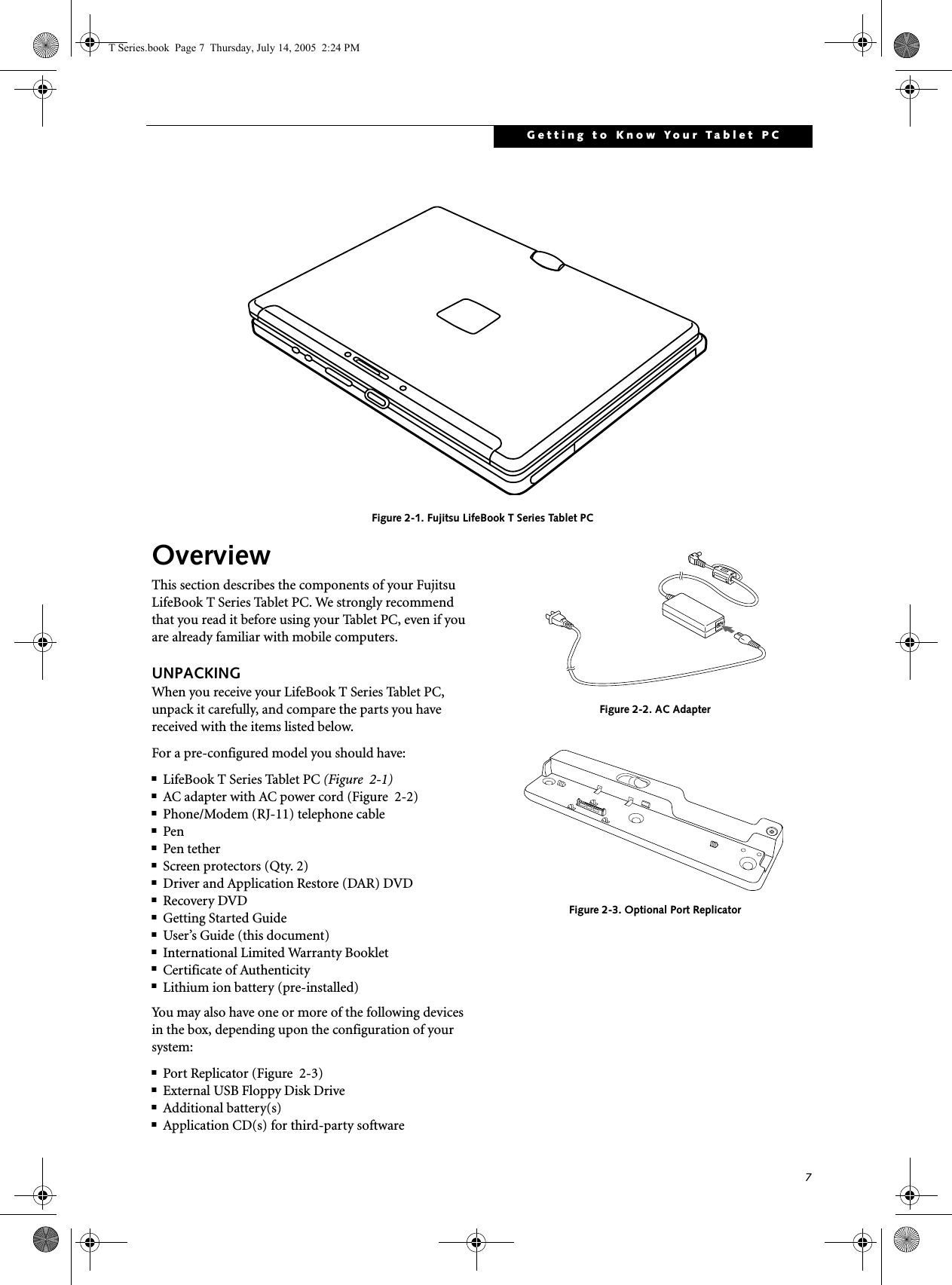
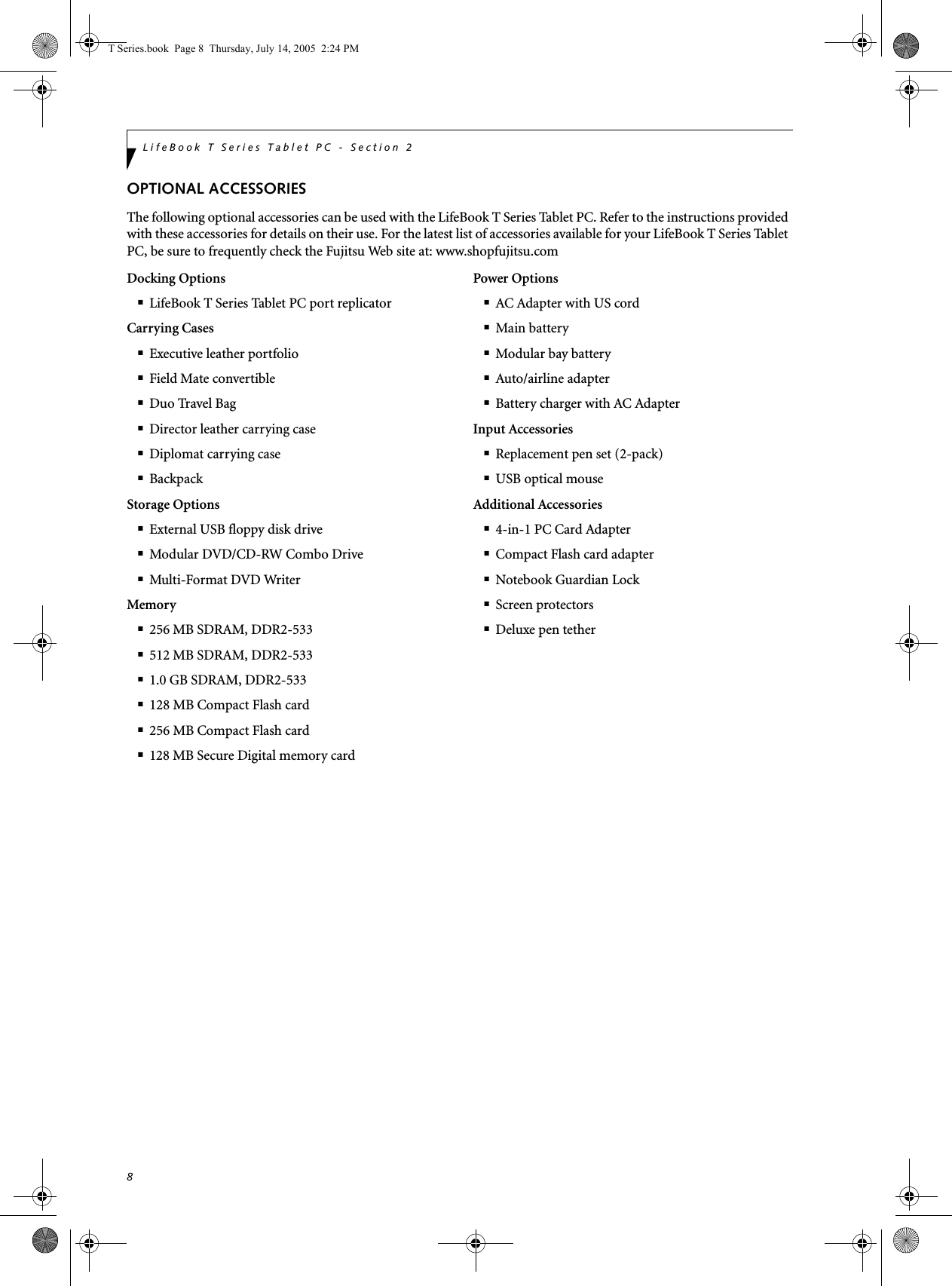
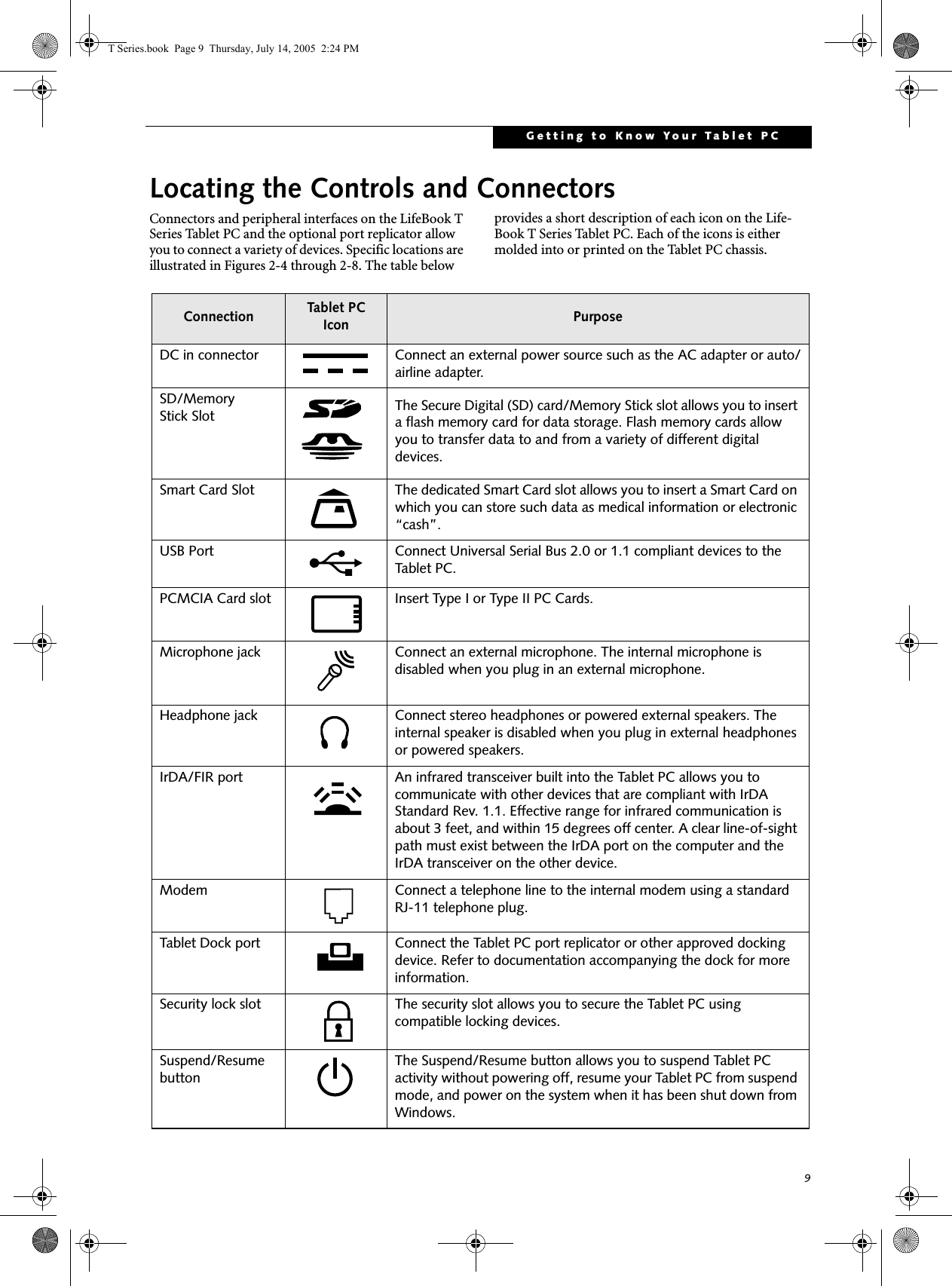
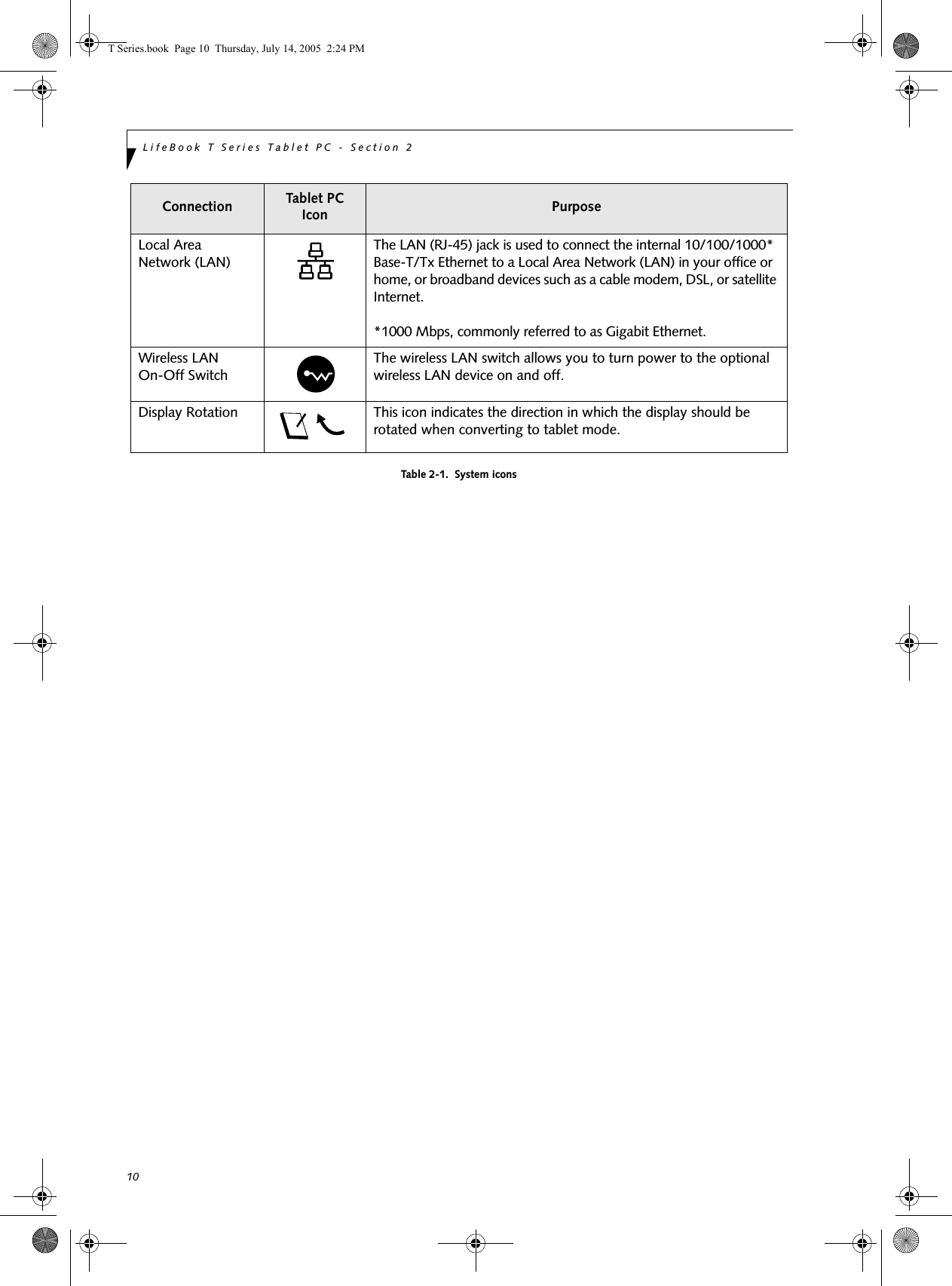

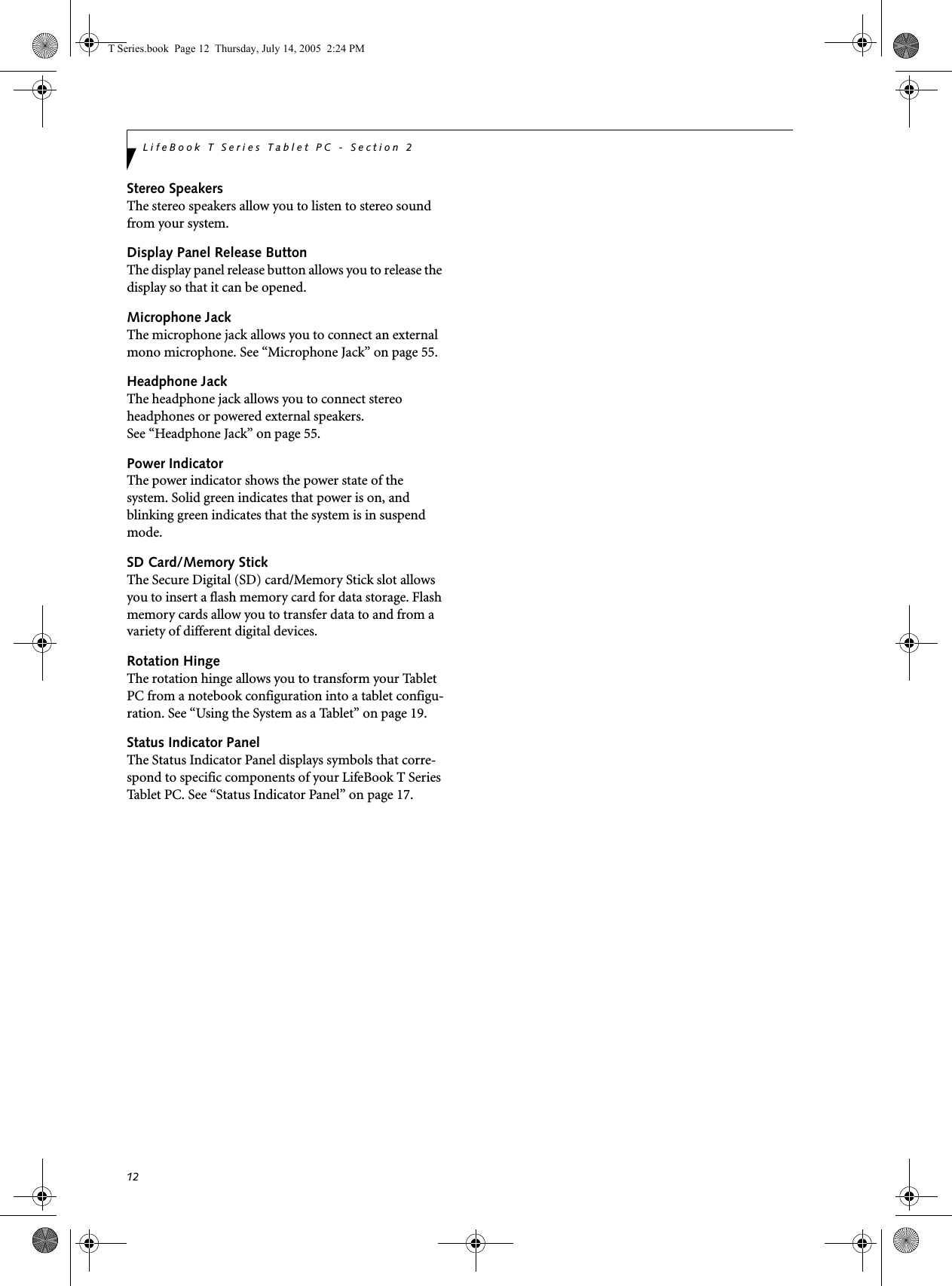

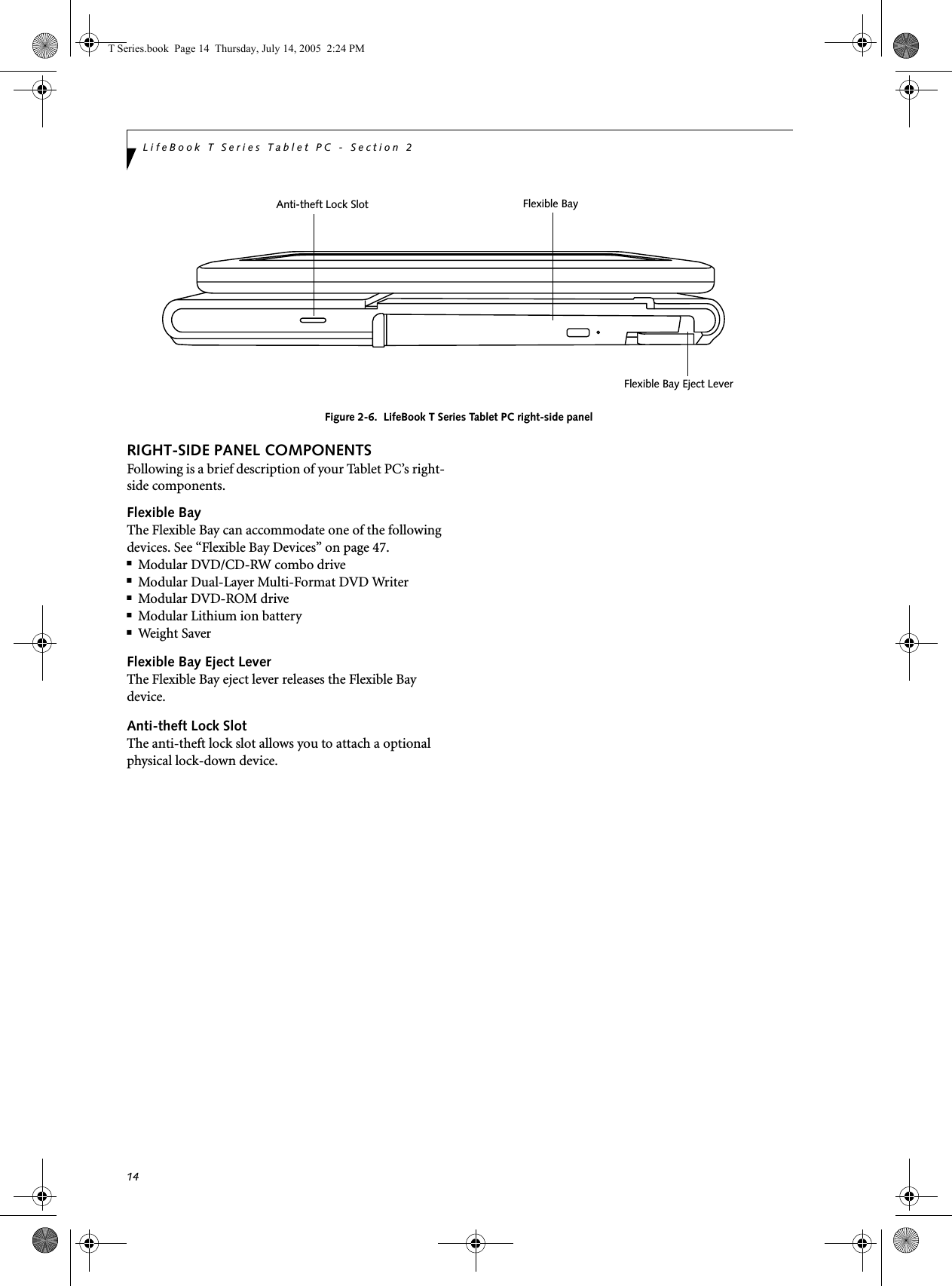
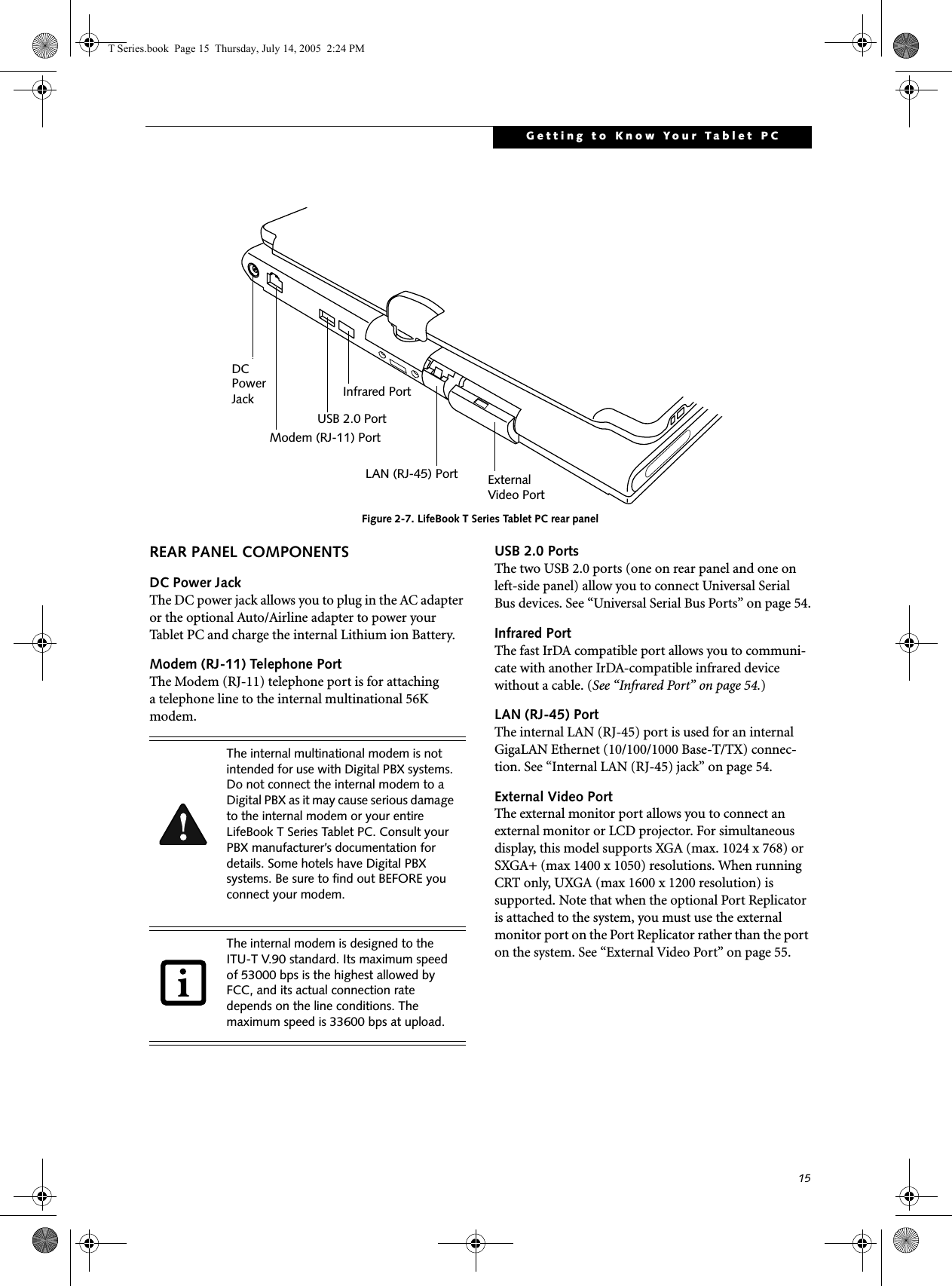
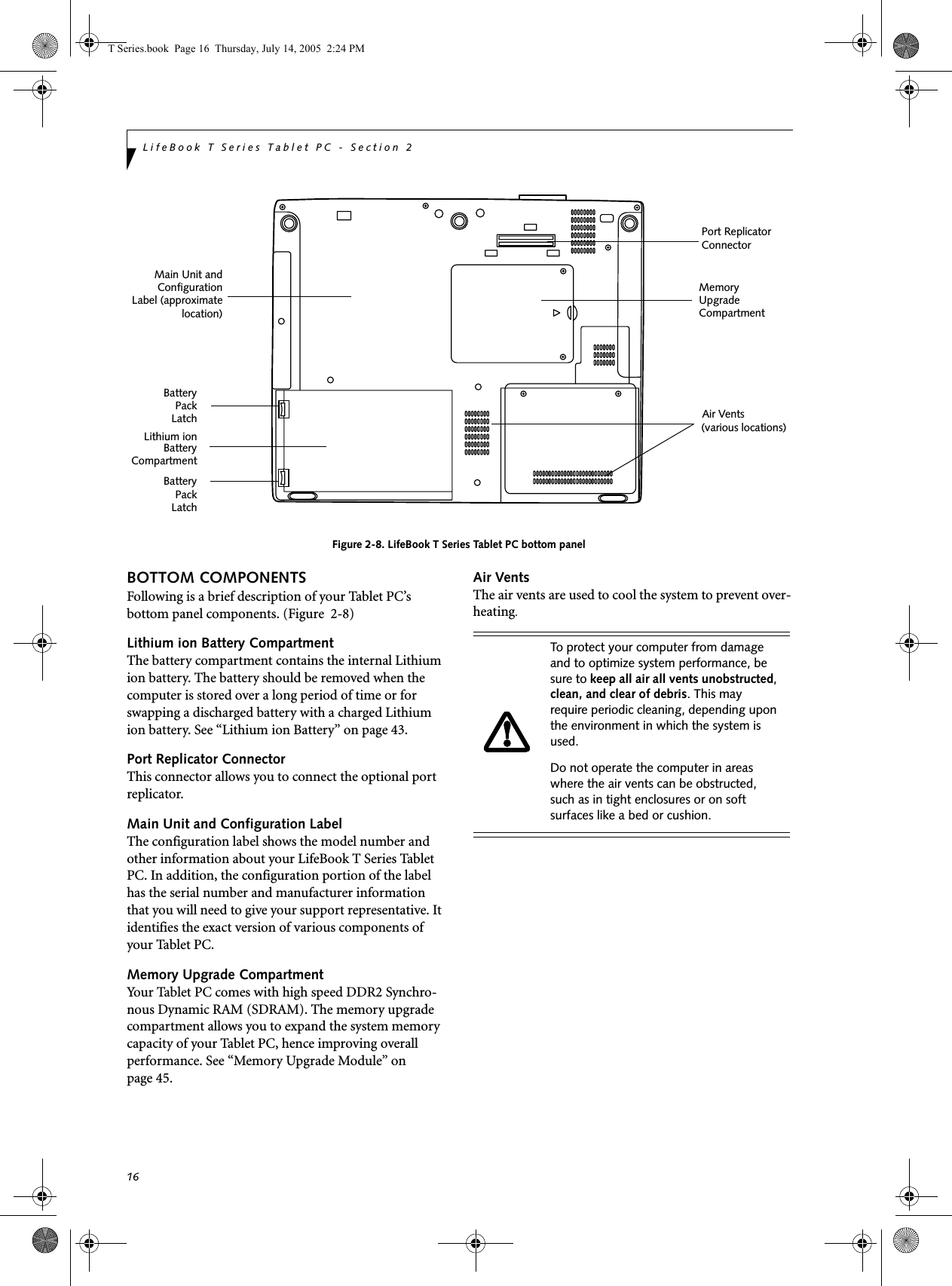
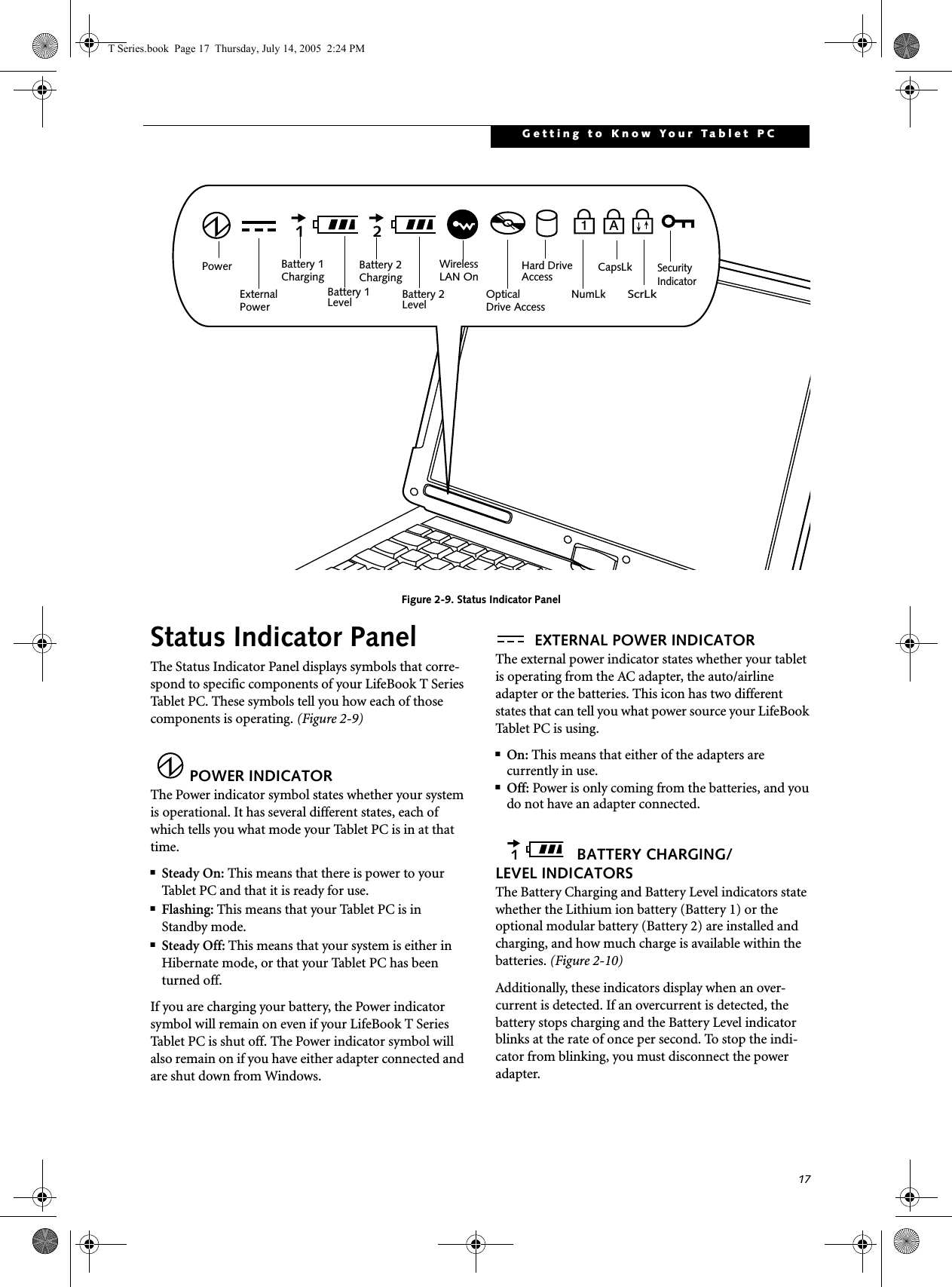
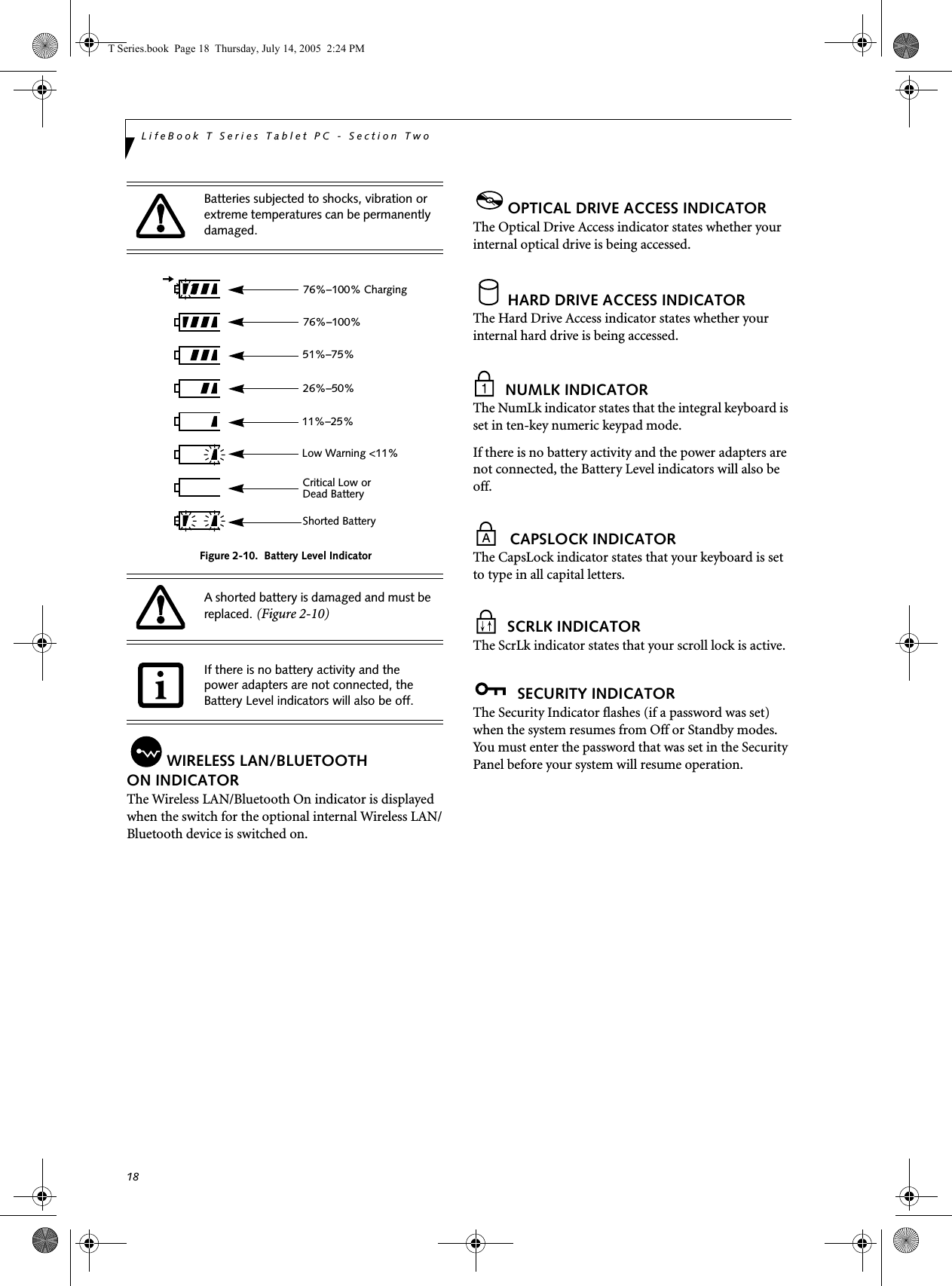

![20LifeBook T Series Tablet PC - Section TwoFigure 2-13. Fully open displayFigure 2-14. Rotating the displayFigure 2-15. Display rotated completelyFigure 2-16. System in tablet configurationADJUSTING DISPLAY PANEL BRIGHTNESSOnce you have turned on your Tablet PC, you may want to adjust the brightness level of the screen to a more comfortable viewing level. There are two ways to adjust the brightness, keyboard and power management utility. Using Keyboard to Adjust BrightnessAdjusting the brightness using the keyboard changes the system setting (i.e., the settings you make via the func-tion keys automatically changes the brightness settings in the system’s Pen and Tablet Settings). ■[Fn+F6]: Pressing repeatedly will lower the brightness of your display.■[Fn+F7]: Pressing repeatedly will increase thebrightness of the display.Using Power Management to Adjust BrightnessTo adjust brightness with the power management utility, click Start -> Control Panel -> Tablet and Pen Settings. Select the Display tab and set the screen brightness slider for battery and AC power scenarios.Using the Fujitsu Menu to Adjust BrightnessTo adjust brightness using the Fujitsu menu, click on the Fujitsu Menu icon in the system tray in the lower right corner of the screen (or double-click the Function button). From the menu that appears, select Brightness Control. The Tablet and Pen Settings window will open. Select the Display tab and set the screen brightness slider for battery and AC power scenarios. 90oIf using AC power your brightness setting is set to its highest level by default. If using battery power your brightness settings is set to approximately mid-level by default.The higher the brightness level, the more power the Tablet PC will consume and the faster your batteries will discharge. For maximum battery life, make sure that the brightness is set as low as possible.T Series.book Page 20 Thursday, July 14, 2005 2:24 PM](https://usermanual.wiki/Fujitsu-Client-Computing/WB0038.App-I1-User-Manual-part-1/User-Guide-639920-Page-26.png)
![21Getting to Know Your Tablet PCFigure 2-17. KeyboardKeyboardUSING THE KEYBOARDYour LifeBook T Series Tablet PC has an integral 84-key keyboard. The keys perform all the standard functions of a 101-key keyboard, including the Windows keys and other special function keys. This section describes the following keys. (Figure 2-17)■Numeric keypad: Your Tablet PC allows certain keys to serve dual purposes, both as standard characters and as numeric and mathematical keys. The ability to toggle between the standard character and numerical keys is controlled through the [NumLk] key.■Cursor keys: Your keyboard contains four arrowkeys for moving the cursor or insertion point to the right, left, up, or down within windows, applications and documents. ■Function keys: The keys labeled [F1] through [F12], are used in conjunction with the [Fn] key to produce special actions that vary depending on what program is running. ■Windows keys: These keys work with your Windows operating system and function the same as the onscreen Start menu button, or the right button on your pointing device.NUMERIC KEYPADCertain keys on the keyboard perform dual functions as both standard character keys and numeric keypad keys. NumLk can be activated by pressing the [NumLk] key. Turning off the NumLk feature is done the same way. Once this feature is activated you can enter numerals 0 through 9, perform addition ( + ), subtraction ( - ),multiplication ( * ), or division ( / ), and enter decimal points ( . ) using the keys designated as ten-key function keys. The keys in the numeric keypad are marked on the front edge of the key to indicate their secondary func-tions. (Figure 2-17) WINDOWS KEYSYour LifeBook T Series Tablet PC has two Windows keys: a Start key and an Application key. The Start key displays the Start menu. This button functions the same as your onscreen Start menu button. The Application key functions the same as your right mouse button and displays shortcut menus for the selected item. (Please refer to your Windows documentation for additional information regarding the Windows keys.) (Figure 2-17)CURSOR KEYSThe cursor keys are the four arrow keys on the keyboard which allow you to move the cursor up, down, left, and right in applications. In programs such as Windows Explorer, it moves the “focus” (selects the next item up, down, left, or right). (Figure 2-17)EndHomeFn Key Start KeyFunction KeysNumeric KeypadApplication Key Cursor Keys(outlined with thickblack line) T Series.book Page 21 Thursday, July 14, 2005 2:24 PM](https://usermanual.wiki/Fujitsu-Client-Computing/WB0038.App-I1-User-Manual-part-1/User-Guide-639920-Page-27.png)
![22LifeBook T Series Tablet PC - Section TwoFUNCTION KEYSYour Tablet PC has 12 function keys, F1 through F12. The functions assigned to these keys differ for each application. You should refer to your software documen-tation to find out how these keys are used. (Figure 2-17)[Fn] KeyThe [Fn] key provides extended functions for theTablet PC and is always used in conjunction with another key. ■[Fn+F3]: Pressing [F3] while holding [Fn] will toggle the Audio Mute on and off.■[Fn+F4]: Pressing [F4] while holding [Fn] will toggle the built-in pointing device on and off. Note that the [Fn+F4] combination only works if Manual Setting is selected in the BIOS. (See “Entering the BIOS Setup Utility” on page 36)■[Fn +F5]: Pressing [F5] while holding [Fn] allows you to toggle between video compensation and no compensation. (Video compensation controls spacing on the display. When it is enabled, displays with less than 1024 x 768 or 800 x 600 pixel resolution will still cover the entire screen.)■[Fn+F6]: Pressing [F6] repeatedly while holding [Fn] will lower the brightness of your display. Note that adjusting the brightness using the keyboard changes the system setting.■[Fn+F7]: Pressing [F7] repeatedly while holding [Fn] will increase the brightness of the display.■[Fn+F8]: Pressing [F8] repeatedly while holding [Fn] will decrease the volume of your Tablet PC.■[Fn+F9]: Pressing [F9] repeatedly while holding [Fn] will increase the volume of your Tablet PC.■[Fn+F10]: Pressing [F10] while holding [Fn] allows you to change your selection of where to send your display video. Each time you press the combination of keys you will step to the next choice. The choices, in order, are: built-in display panel only, both built-in display panel, and external monitor or external moni-tor only.T Series.book Page 22 Thursday, July 14, 2005 2:24 PM](https://usermanual.wiki/Fujitsu-Client-Computing/WB0038.App-I1-User-Manual-part-1/User-Guide-639920-Page-28.png)
![23Getting to Know Your Tablet PCFigure 2-18. LifeBook T Series Tablet PC Security/Tablet PC Buttons LifeBook Security/Tablet PC ButtonsA unique feature of your LifeBook T Series Tablet PC is the array of Security and Tablet PC buttons. These buttons allow you to secure your Tablet PC from unauthorized use and to launch specific applications with the touch of a button. If the security system is activated, upon starting your Tablet PC or resuming from Standby, Hibernate, or shut-down mode the security system will require you to enter a password code using the security buttons. After you enter the correct password, your Tablet PC will resume operation. The five security/Tablet PC buttons are located on the bottom right-hand side of the display when it is config-ured to be used as a notebook. (Figure 2-18) Security functions: All five buttons are used when implementing security functions. Four of the buttons are used to enter the password, and the fifth is used as an Enter button. See the right-hand column of Table 2-2.Tablet PC functions: All five of the buttons have primary functions. Four of the buttons have secondary functions when used as application buttons. The secondary functions are activated by pressing the Func-tion (Fn) button while pressing the application button. See Table 2-2 for specific functions. The secondary func-tions of the Application A and B buttons can be changed to launch any application. See “Changing Tablet PC Button Functions” on page 24 Table 2-2. Security/Tablet PC Button Functions(1) Application A Button(3) Button 3(2) Application B Button(4) Button 4Enter ButtonWhen the system is logging on or when it is locked (i.e., when you have the Logon or Computer Locked window showing on your desktop), the A and B buttons act as [Tab] and [Enter] keys, respectively. Button Icon Primary Function Secondary Function(Fn + Button)Security Panel Function(Pre-boot and resuming from suspend)Page Down User-defined Application A(Default = Calculator) Security Button 1Page Up User-Defined Application B(Default = MS Journal) Security Button 2Screen Rotation VGA-Out Security Button 3Secondary Function Selection Fujitsu Menu Utility Security Button 4Ctl+Alt+Del Button None Security Enter ButtonT Series.book Page 23 Thursday, July 14, 2005 2:24 PM](https://usermanual.wiki/Fujitsu-Client-Computing/WB0038.App-I1-User-Manual-part-1/User-Guide-639920-Page-29.png)
![24LifeBook T Series Tablet PC - Section TwoPage Down / Application A ButtonWhen you press the Page Down button when the system is running, each press of the button will scroll the screen down one frame. This allows you to navigate quickly through large documents.When you press the Fn button then press and release the Page Down/Application A button, you will automati-cally start whichever program is assigned to the button. The default application for this button is Calculator.See “Changing Tablet PC Button Functions” on page 24 to select a different application for this button.Page Up / Application B ButtonWhen you press the Page Up button when the system is running, each press of the button will scroll the screen up one frame. This allows you to navigate quickly through large documents.When you press the Fn button then press and release the Page Up/Application A button, you will automatically start whichever program is assigned to the button. The default application for this button is Microsoft Journal.See “Changing Tablet PC Button Functions” on page 24 to select a different application for this button.Screen Rotation / VGA-Out ButtonThe screen rotation feature would normally be used only when the system is configured as a tablet. When you would like to use the tablet as an eBook, for example, you would use the portrait orientation; when accessing spreadsheets or using the system as a notebook, you would more typically use landscape orientation.When the system is changed to tablet configuration, the orientation automatically changes to portrait mode by default. When you press the Screen Rotation / VGA-Out button, the system screen orientation changes from portrait (vertical) to landscape (horizontal) or from landscape to portrait. Function / Fujitsu Menu Utility ButtonThe Function button works in conjunction with the other application buttons to provide additional func-tionality for the buttons. Refer to specific details above.Pressing the Fn button twice in succession causes the Fujitsu Menu Utility to appear on your screen, allowing you to modify certain system settings.Ctl+Alt+Del ButtonPressing and holding the Ctl-Alt-Del button for up to 750 milliseconds launches the Logon screen or the Windows Task Manager (if the system hasn’t yet been configured).CHANGING TABLET PC BUTTON FUNCTIONSThe Application A and B buttons can be changed to launch a program or perform an action you select. By default, the Application A button launches the Calcu-lator, and the Application B button launches MS Journal.To launch different applications or cause the Application A or B buttons to perform a specific action:1. Double-click on the Tablet and Pen Settings icon in the Control Panel. 2. Select the Tablet Buttons tab and select the button you would like to change from the list.3. Click [Change] and open the drop down list in the Action: field.4. Select the action you would like the button to perform. If you want to launch a program, click on Launch an Application then browse to the location of the program.5. Click [OK], then click [OK] again. The buttons will now perform the actions you have assigned to them.SETTING UP LIFEBOOK SECURITY PANELWhen you receive your Tablet PC, the security panel application is pre-installed without any passwords. The following sections provide detailed information on your security panel, how to set, change or remove passwords.Numbered ButtonsUse these buttons to enter your password.(Figure 2-18)Enter ButtonAfter entering the button strokes, push this button to enter the password into the Tablet PC. (Figure 2-18)PASSWORDSThe user and supervisor password may be set on this Tablet PC. A supervisor password is typically the same for all tablets and notebooks in a work group, office, or company to allow for system management. Individual computers in a group environment should not use a common password. A password consists of one to five button strokes plus the enter button. A valid stroke consists of pushing one or up to four buttons simulta-neously. The screen orientation default can be changed by going to the Control Panel and double-clicking on the Fujitsu Display Control icon and selecting the desired defaults from the Display Orientation section. After changing the defaults, click [OK]. T Series.book Page 24 Thursday, July 14, 2005 2:24 PM](https://usermanual.wiki/Fujitsu-Client-Computing/WB0038.App-I1-User-Manual-part-1/User-Guide-639920-Page-30.png)
![25Getting to Know Your Tablet PCThe following are valid button strokes: ■Pushing [4] by itself■Pushing [2] and [3] at the same time■Pushing [1], [2], and [4] at the same time■Pushing [1], [2], [3], and [4] at the same timeThe following are valid passwords. The numbers within braces ({ }) are button strokes using more than one button. ■{[2]+[3]}, [1], [Enter]■[4], [enter]■{[1]+[3]}, {[2]+[3]+[4]}, [1], [4], [2], [Enter]Setting PasswordsWhen shipped from the factory, no passwords are set. You have a choice of having no password or setting a supervisor and user password. You must set the super-visor password before the user password. Setting Supervisor PasswordYou must have set a supervisor password before setting any user passwords. The supervisor password can bypass the user password.1. Go to the Start menu.2. Click on Run.3. Type in:C:\Program Files\Fujitsu\Security Panel Application\Supervisor\ FJSECS.EXE, then press [Enter]4. Follow the on-screen instructions to set theSupervisor password.Setting User Password1 Go to the Start menu.2. Click on All Programs.3. Click on Security Panel Application -> Security Panel Application.4. Follow the on-screen instructions to set theuser password.USING YOUR LIFEBOOK SECURITY PANELThe security lock feature is in effect both when the system resumes from Off, Standby, or Hibernation state. You always need to push the Security Panel buttons to input the user password. Your system will not begin the boot sequence until you enter your supervisor/user password.From Off State1. Turn on your system.2. When the Security Indicator flashes, enter the pass-word and press Enter button.For example, if the password is 22222, first press Button 2 five times and press the Enter button. The Tablet PC will boot to normal operation.From Standby/Hibernation State1. Press your Suspend/Resume button.2. When the Security Indicator flashes, enter the pass-word and press Enter button.The Tablet PC should resume normal operation.Incorrect Password EntryIf an invalid supervisor or user password is entered three times in succession, the system will “beep” for about one minute. If a valid password is entered within a minute (while system beeps), the beeping will stop and the Tablet PC will resume normal operation. If no password is entered or an invalid password is entered while the system beeps, the system will return to its previous locked state (standby or off) and the Security Indicator will go off. To reactivate the Tablet PC after a password failure, you must press the Suspend/Resume button, then enter a correct password.PRECAUTIONSOpening and Closing the CoverBy default, closing the cover automatically places your system into Standby mode. (You can change the action the system takes when the cover is closed by opening the Power Options Properties icon in the Control Panel, and selecting the Advanced tab. Make a choice from the drop down menu for “When I close the lid of my portable computer:” and click the [OK] button.) Opening the cover does not automatically place the Tablet PC into normal operation. Instead, you must enter the proper security password after pushing the Suspend/Resume button.■The purpose of supervisor password is to be able to bypass the user password in case the user password is forgotten. The supervisor password alone will not lock the system.■You must set the supervisor and user passwords for the security panel to work.You may change or remove the supervisor or user password by repeating the steps defined above.Remember the user password you specified on the Security Panel Application. If you forget the password you will not be able to use your computer. The supervisor pass-word can override the user password.T Series.book Page 25 Thursday, July 14, 2005 2:24 PM](https://usermanual.wiki/Fujitsu-Client-Computing/WB0038.App-I1-User-Manual-part-1/User-Guide-639920-Page-31.png)
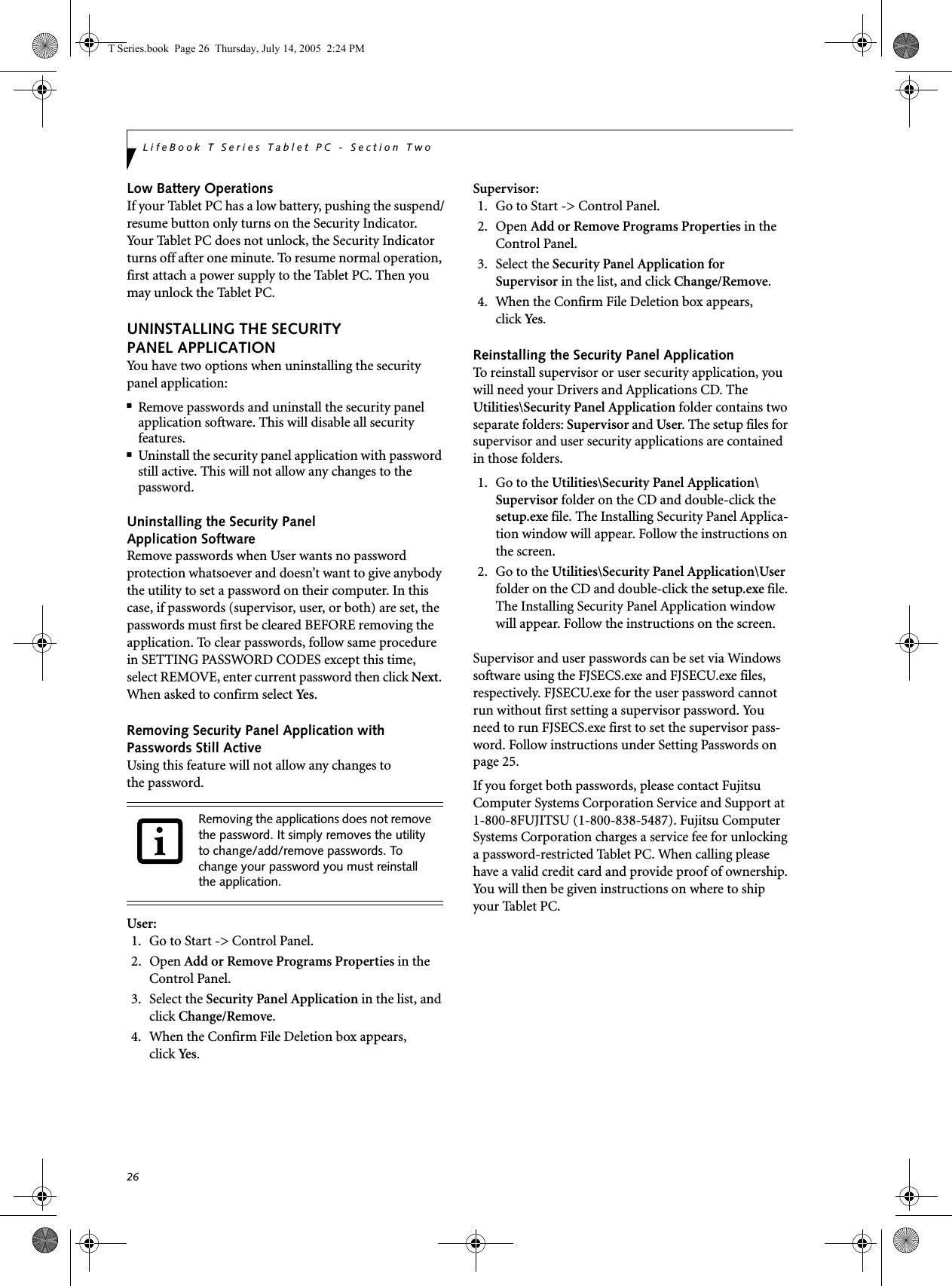
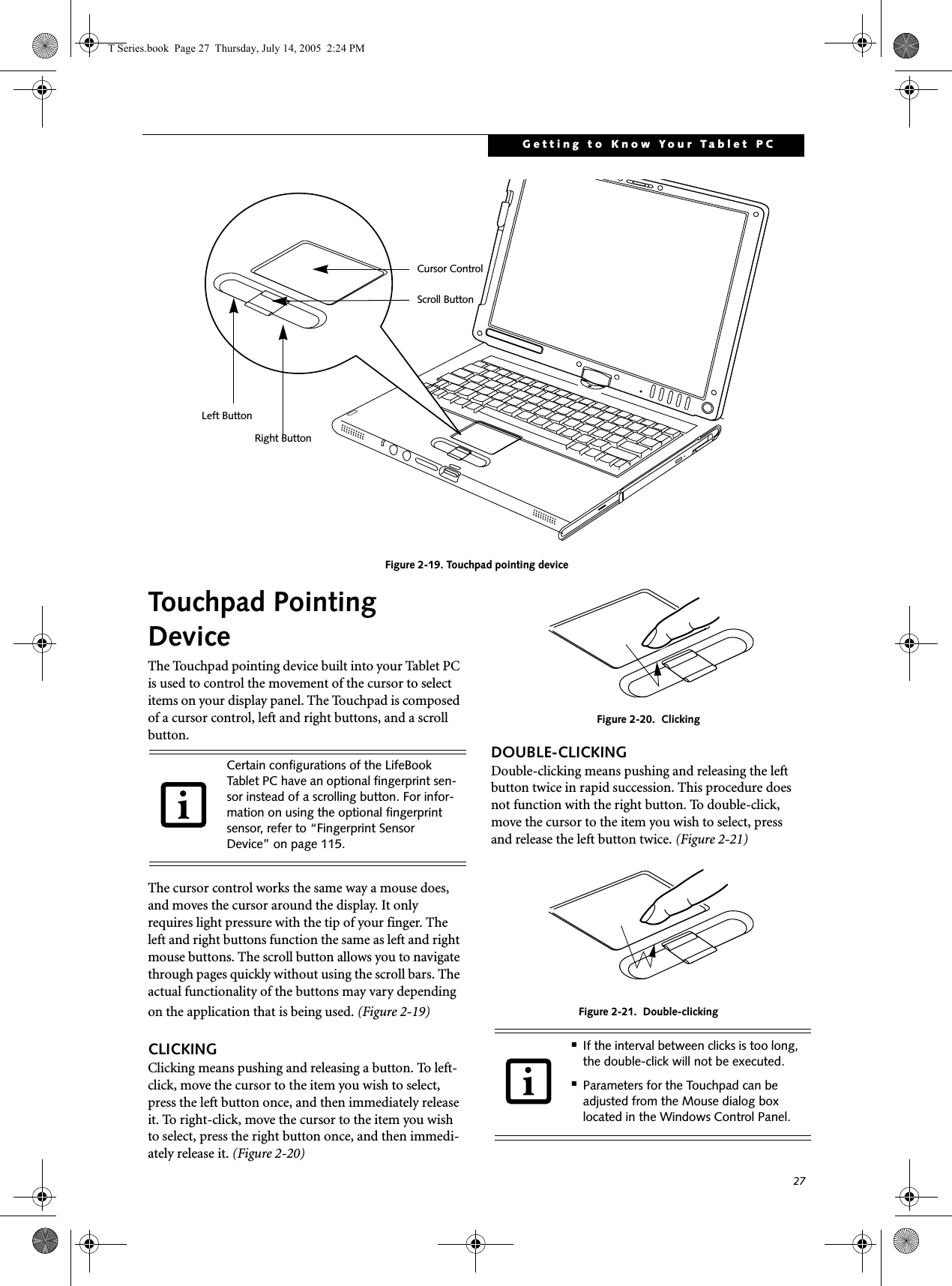
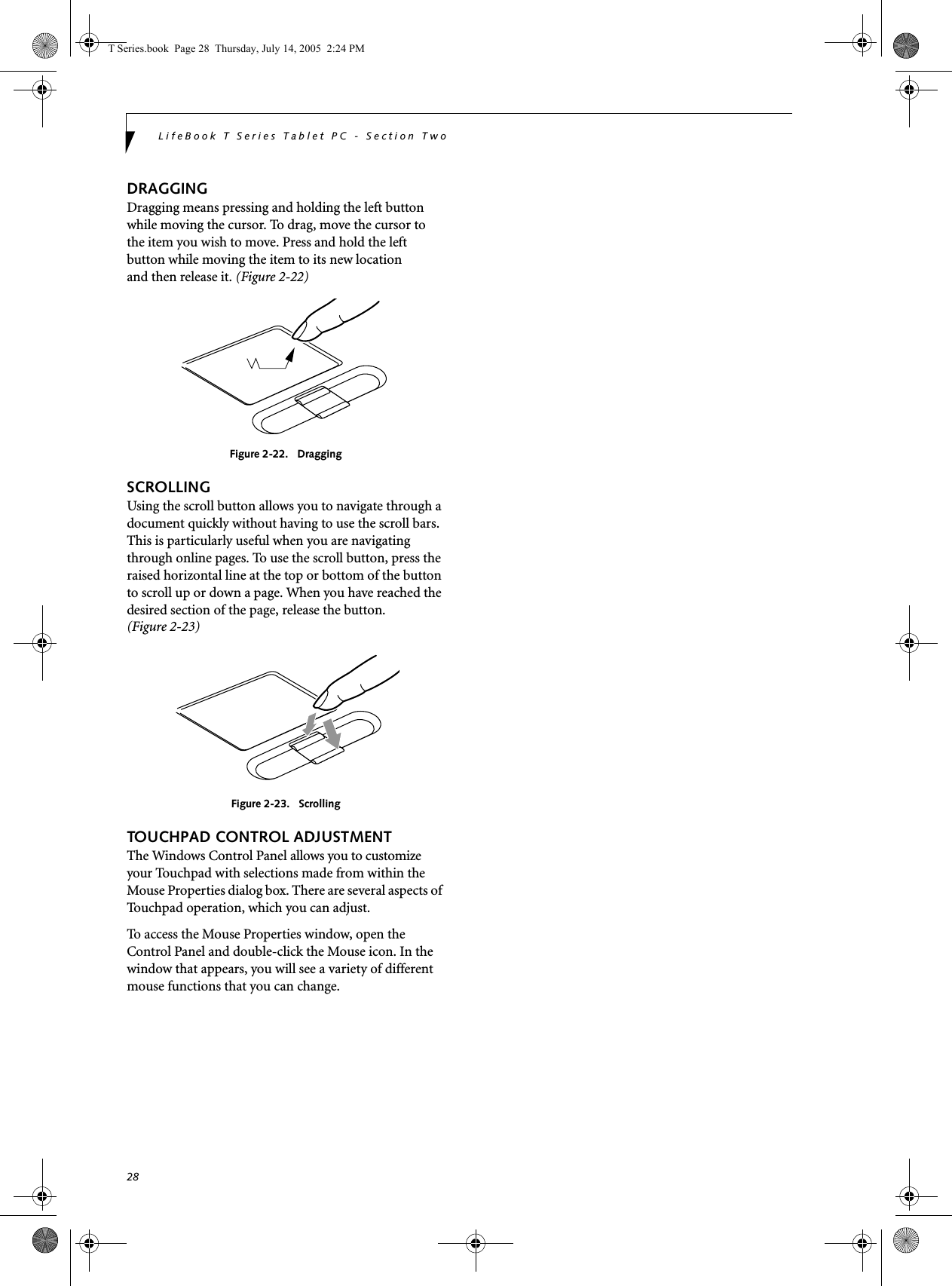
![29Getting to Know Your Tablet PCVolume ControlYour Fujitsu Tablet PC has multiple volume controls which interact with each other. CONTROLLING THE VOLUMEThe volume can be controlled in several different ways:■Volume can be set from within the Volume Control on the Taskbar.■Volume can be controlled with the [F8] and [F9] func-tions keys. Pressing [F8] repeatedly while holding [Fn] will decrease the volume of your Tablet PC. Pressing [F9] repeatedly while holding [Fn] will increase the volume of your Tablet PC.■Volume can be controlled by many volume controls that are set within individual applications.■Certain external audio devices you might connect to your system may have hardware volume controls.■Each source discussed above puts an upper limit on the volume level that must then be followed by the other sources. We recommend that you experiment with the various volume controls to discover the optimal sound level.Any software that contains audio files will also contain a volume control of its own. If you install an external audio device that has an independent volume control, the hardware volume control and the software volume control will interact with each other. It should be noted that if you set your software volume to Off, you will override the external volume control setting. There are twenty-six levels through which the function keys cycle. T Series.book Page 29 Thursday, July 14, 2005 2:24 PM](https://usermanual.wiki/Fujitsu-Client-Computing/WB0038.App-I1-User-Manual-part-1/User-Guide-639920-Page-35.png)
![30LifeBook T Series Tablet PC - Section TwoPen and Active DigitizerUSING THE PENYou can use the LifeBook T Series Tablet PC pen to generate and create electronic “ink”, to select items, and to navigate through programs on the Tablet PC. Programs that support handwriting recognition also allow you to write characters directly on the screen with the pen. You can also use the pen as a drawing tool.Figure 2-24. LifeBook T Series PenThe screen reacts when the pen tip is approximately 1/8 inch (3-5 mm) from the screen. The pen has three switches: a tip switch and a barrel button toggle switch with switches at both ends. By default, the tip switch corresponds to the left mouse button, and the front toggle (closest to the pen tip) barrel button switch corre-sponds to the right mouse button (when used in combi-nation with the tip switch). The rear toggle of the barrel button switch acts as an electronic ink “eraser”.The functions of the rear toggle and the tip click pressure can be changed by clicking [Start] -> Control Panel, and double-clicking the Fujitsu Pen Settings icon. To change the rear toggle function, select the drop-down list to select a new function, then click [Apply]. If you don’t want the rear toggle to have any function, select Ignore from the list. Adjusting the click pressure determines how much pres-sure must be put on the pen tip in order for the screen to react. The softer it is set, less pressure is required; the harder it is set, more pressure is required. To change the click pressure, use the slider bar to make the click pres-sure harder or softer, then click [Apply]. Here are some hints that may help you use the pen more effectively:• To activate the tip switch, tap or hold the pen tip against the screen.• To activate the barrel button switch, press and hold the end of the button you wish to use (front toggle is the right mouse button switch; the rear toggle acts as an electronic “eraser”).• To move the cursor, hold the pen tip within 1/8 inch (3 - 5 mm) from the screen and move the pen.• To start a program, double-tap the pen tip (tap the pen tip twice rapidly) on the program icon as you would double-click a mouse.•To select an object, tap the pen tip on the object once. •To double-click an object, quickly tap the object twice.INSTALLING A PEN TETHERTo prevent dropping or losing your pen, you should attach it to your system using the pen tether that is included with the system. To attach the pen tether to your Tablet PC, perform the following steps:1. Attach the end of the pen tether with the smaller loop to your pen. To do so, push the end of the tether through the hole in the pen, then thread the opposite end of the tether through the loop. (See Figure 2-25.)You are advised to use a screen protector on your system display to minimize the chance of its being scratched. Screen protectors are available from the Fujitsu Web site at us.fujitsu.com/computers. The LifeBook T Series Tablet PC pen is a high-quality electronic instrument that can be damaged if used improperly. Treat the pen as you would any precision device. Observe the following guidelines:• Do not tap the pen on surfaces other than the Tablet PC screen.• Do not try to turn the thumb grip on the pen; it is designed for inserting and removing the pen from the pen holder.• Never store the pen with the tip bearing the weight of the pen (e.g., sitting tip down in a pencil cup). Storing the pen tip down could distort the internal mechanism over a period of time (especially in higher temperatures), causing the tip to act as if it is always depressed. The pen should be stored in the pen holder when not in use.Tip SwitchBarrel SwitchUse only the pen provided with your Tablet PC. Do not use substitutes that were not designed for the LifeBook T Series Tablet PC.T Series.book Page 30 Thursday, July 14, 2005 2:24 PM](https://usermanual.wiki/Fujitsu-Client-Computing/WB0038.App-I1-User-Manual-part-1/User-Guide-639920-Page-36.png)


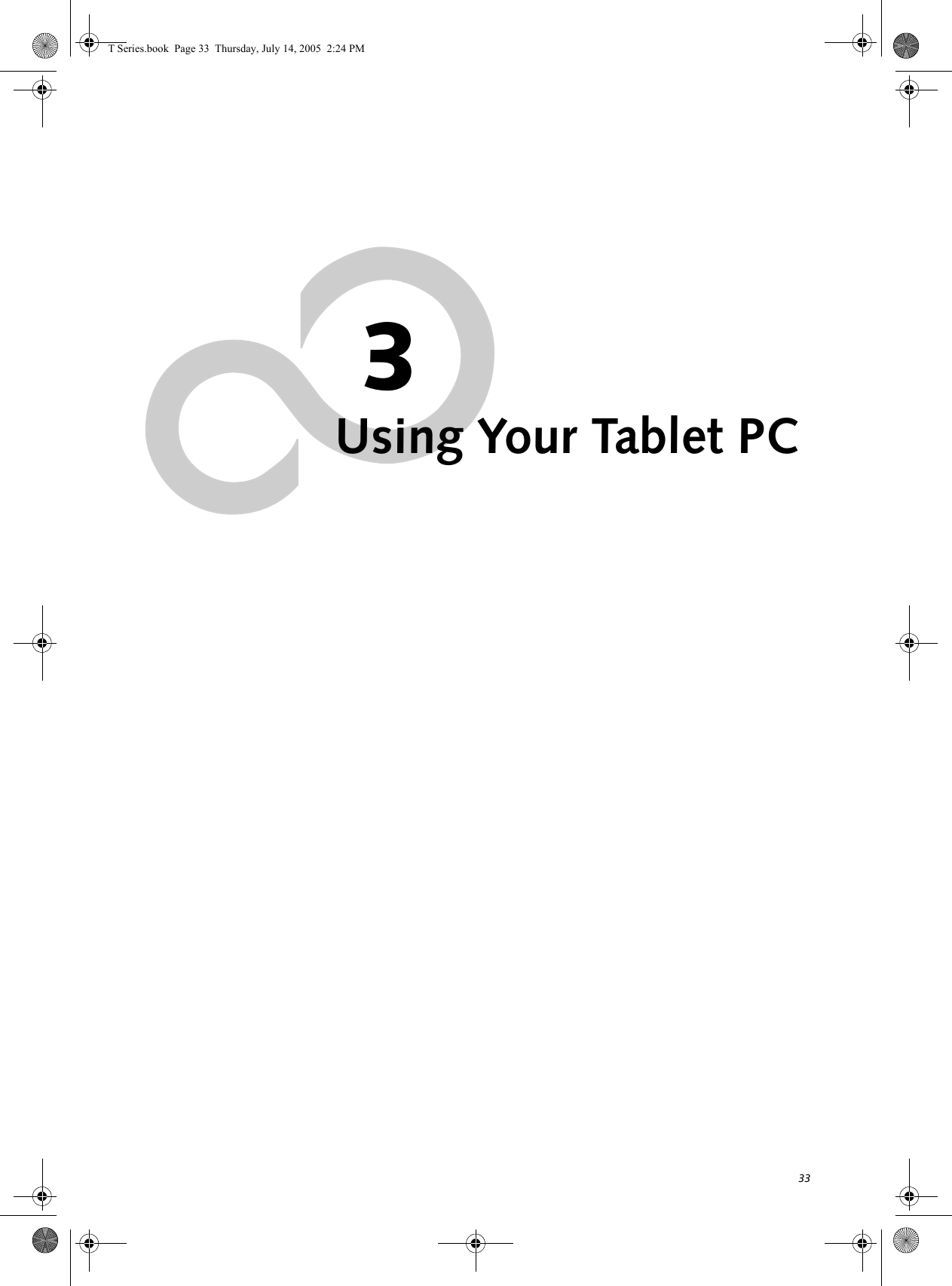
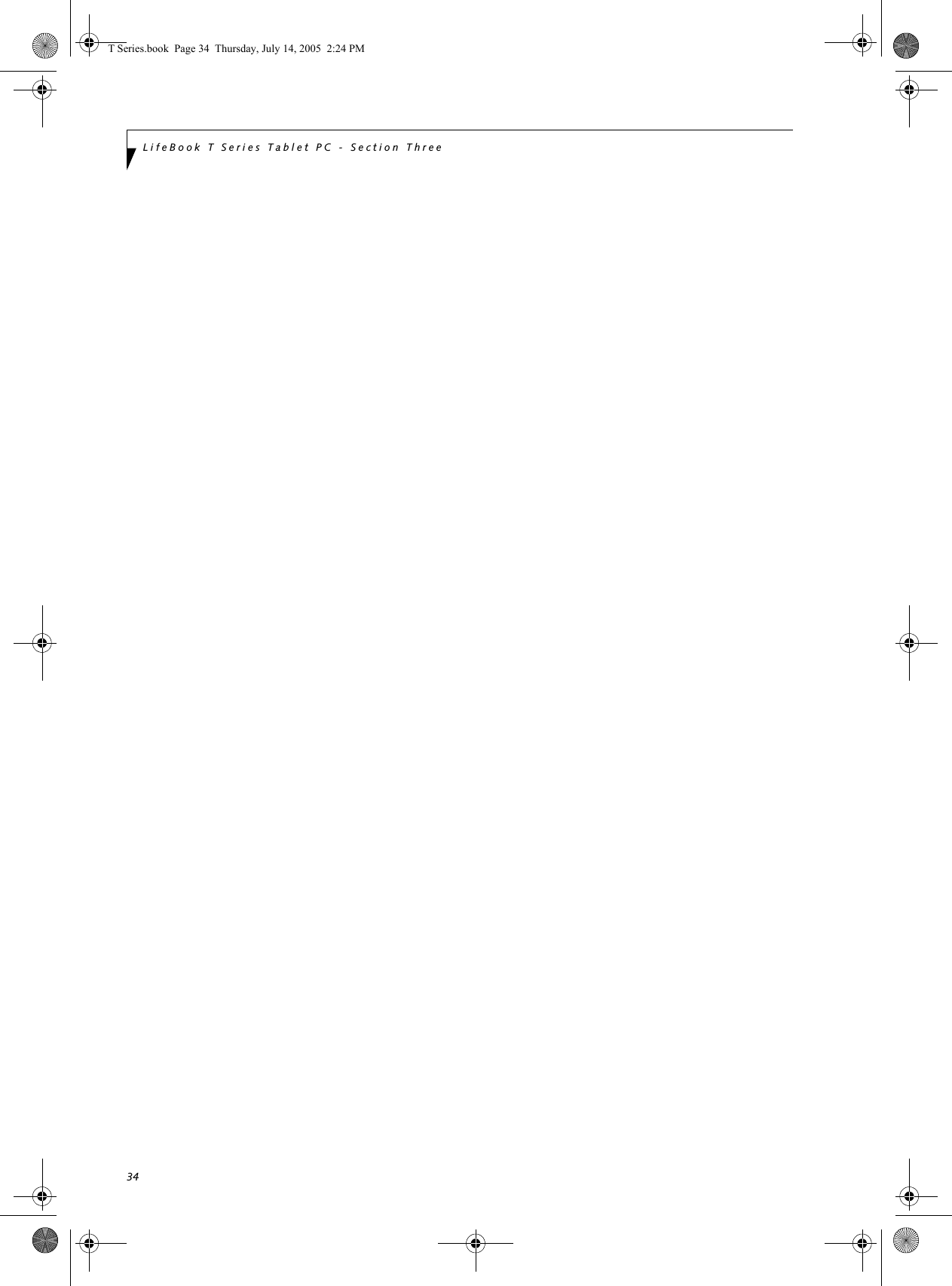
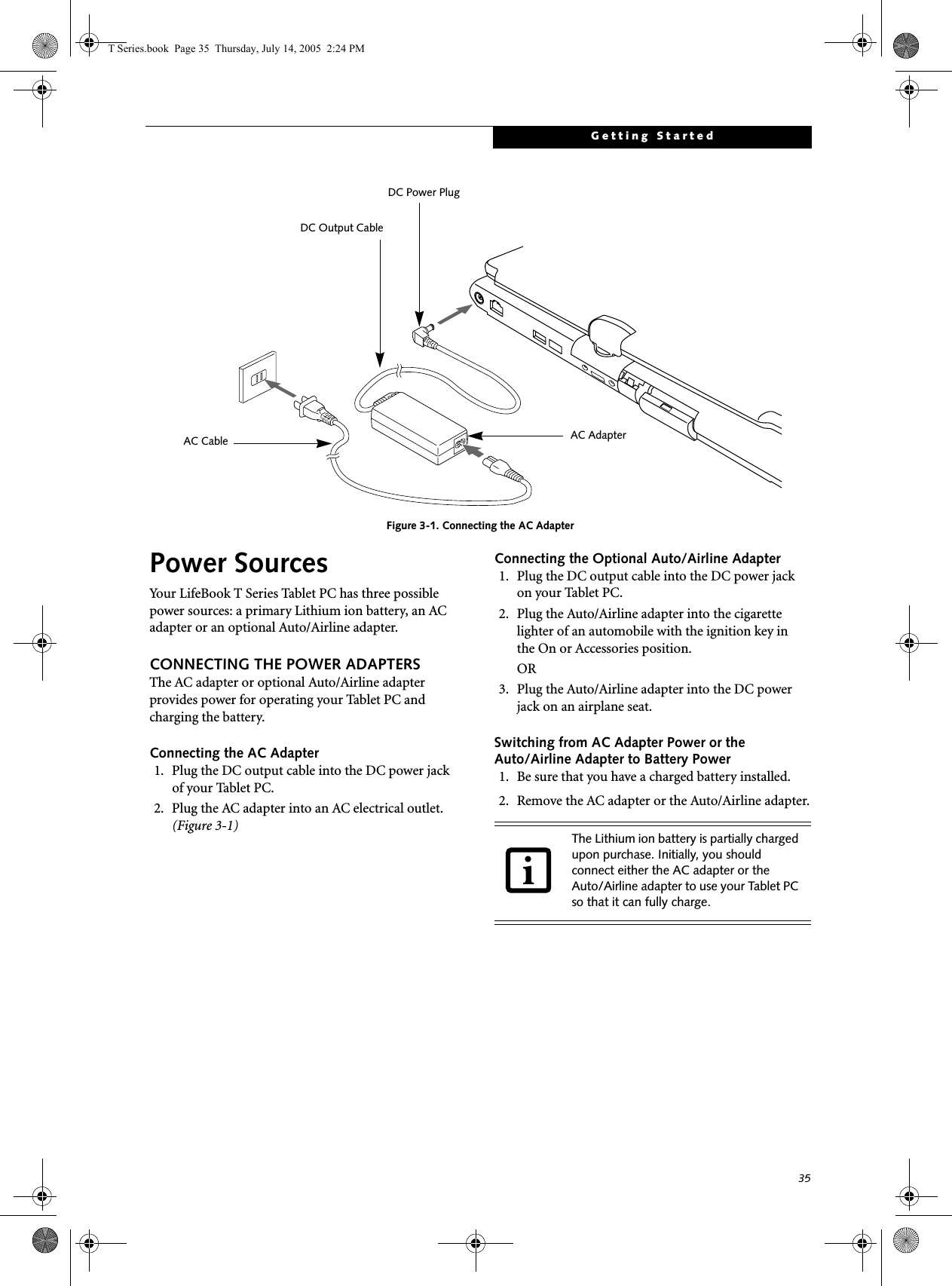
![36LifeBook T Series Tablet PC - Section ThreeStarting Your Tablet PCPOWER ONThe Suspend/Resume button is used to turn on your LifeBook T Series Tablet PC from its off state. Once you have connected your AC adapter or charged the internal Lithium ion battery, you can power on your Tablet PC. (See figure 2-4 on page 11 for location).Press the Suspend/Resume button to start your system. When you are done working you can either leave your Tablet PC in Standby mode, See “Standby Mode” on page 38, or you can turn it off. See “Power Off” on page 40.When you Power On your Tablet PC, it will perform a Power On Self Test (POST) to check the internal parts and configuration for correct functionality. If a fault is found, your Tablet PC will emit an audio warning and/or an error message will be displayed. See “Power On Self Test Messages” on page 67. Depending on the nature of the problem, you may be able to continue by starting the operating system or by entering the BIOS setup utility and revising the settings.After satisfactory completion of the Power On Self Test (POST), your Tablet PC will load your operating system.BOOT SEQUENCEThe procedure for starting-up your Tablet PC is termed the Bootup sequence and involves your Tablet PC’s BIOS. When your Tablet PC is first turned on, the main system memory is empty, and it needs to find instruc-tions to start up your Tablet PC. This information is in the BIOS program. Each time you power up or restart your Tablet PC, it goes through a boot sequence which displays a Fujitsu logo until your operating system is loaded. During booting, your Tablet PC is performing a standard boot sequence including a Power On Self Test (POST). When the boot sequence is completed without a failure and without a request for the BIOS Setup Utility, the system displays the operating system’s opening screen.The boot sequence is executed when:■You turn on the power to your Tablet PC.■You restart your Tablet PC from the WindowsShut Down dialog box.■The software initiates a system restart. Example:When you install a new application.BIOS SETUP UTILITYThe BIOS Setup Utility is a program that sets up the operating environment for your Tablet PC. Your BIOSis set at the factory for normal operating conditions, therefore there is no need to set or change the BIOS’ environment to operate your Tablet PC.The BIOS Setup Utility configures:■Device control feature parameters, such as changingI/O addresses and boot devices.■System Data Security feature parameters, suchas passwords.Entering the BIOS Setup UtilityTo enter the BIOS Setup Utility do the following: 1. Turn on or restart your Tablet PC.2. Press the [F2] key once the Fujitsu logo appearson the screen. This will open the main menuof the BIOS Setup Utility with the currentsettings displayed.3. Press the [RIGHT ARROW] or [LEFT ARROW] key to scroll through the other setup menus to review or alter the current settings.BIOS GuideA guide to your Tablet PC’s BIOS is available online. Please visit our service and support Web site at http://www.computers.us.fujitsu.com/support. Once there, select Support, then select Tablet PCs under User’s Guides. Select LifeBook Tablet PC BIOS Guides from the pull-down menu for your Tablet PC series. If you are unsure of your Tablet PC’s BIOS number, refer to your packing slip.When you turn on your Tablet PC, be sure you have a power source. This means that a battery is installed and charged, or that the AC or Auto/Airline adapter is connected and has power.When the system display is closed, the Suspend/Resume button is disabled. This feature prevents the system from being accidentally powered up when not in use. Never turn off your Tablet PC during the Power On Self Test (POST) or it will cause an error message to be displayed when you turn your Tablet PC on the next time. See “Power On Self Test Messages” on page 67If your data security settings require it, you may be asked for a password before the BIOS main menu will appear.T Series.book Page 36 Thursday, July 14, 2005 2:24 PM](https://usermanual.wiki/Fujitsu-Client-Computing/WB0038.App-I1-User-Manual-part-1/User-Guide-639920-Page-42.png)
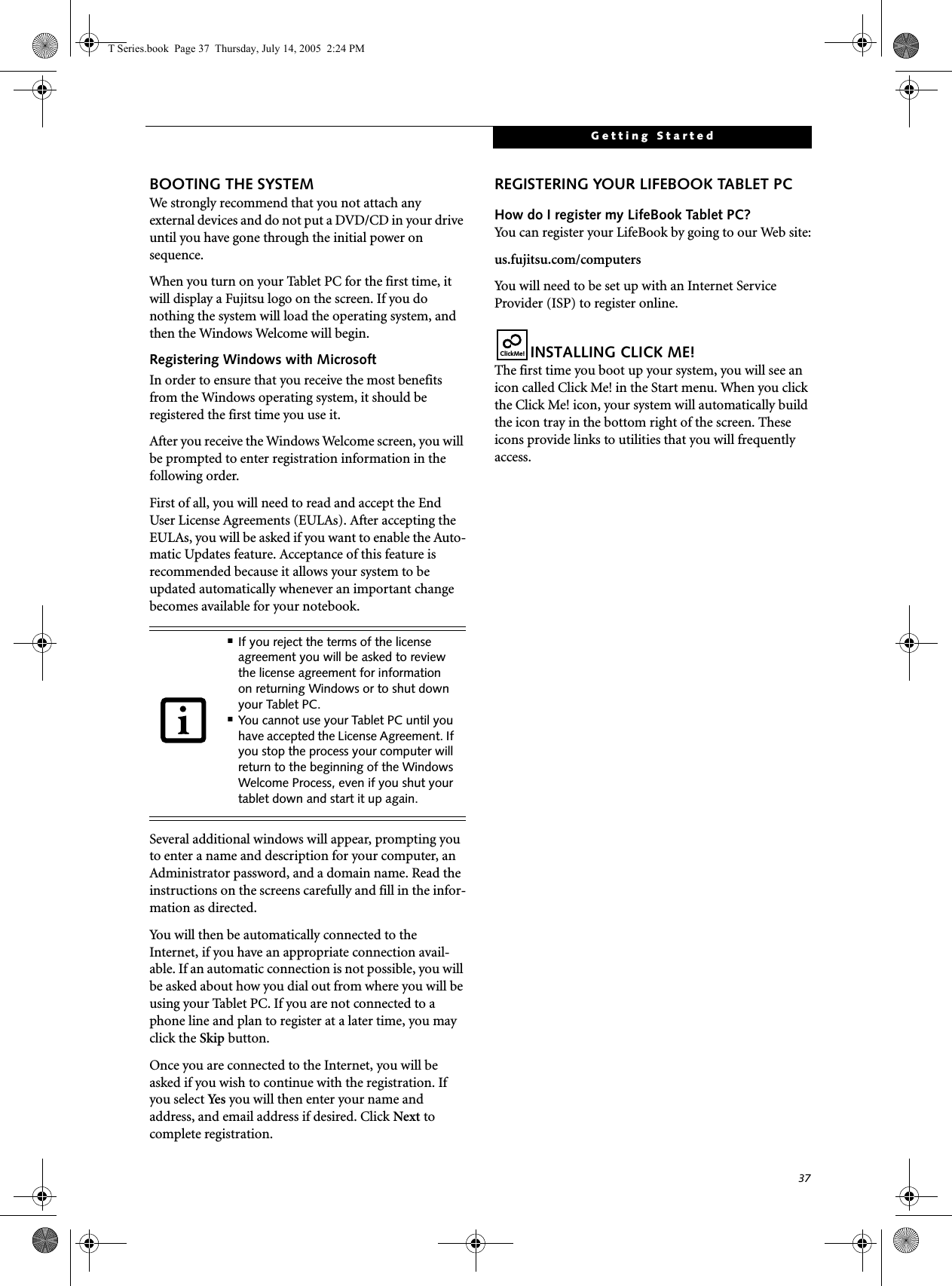
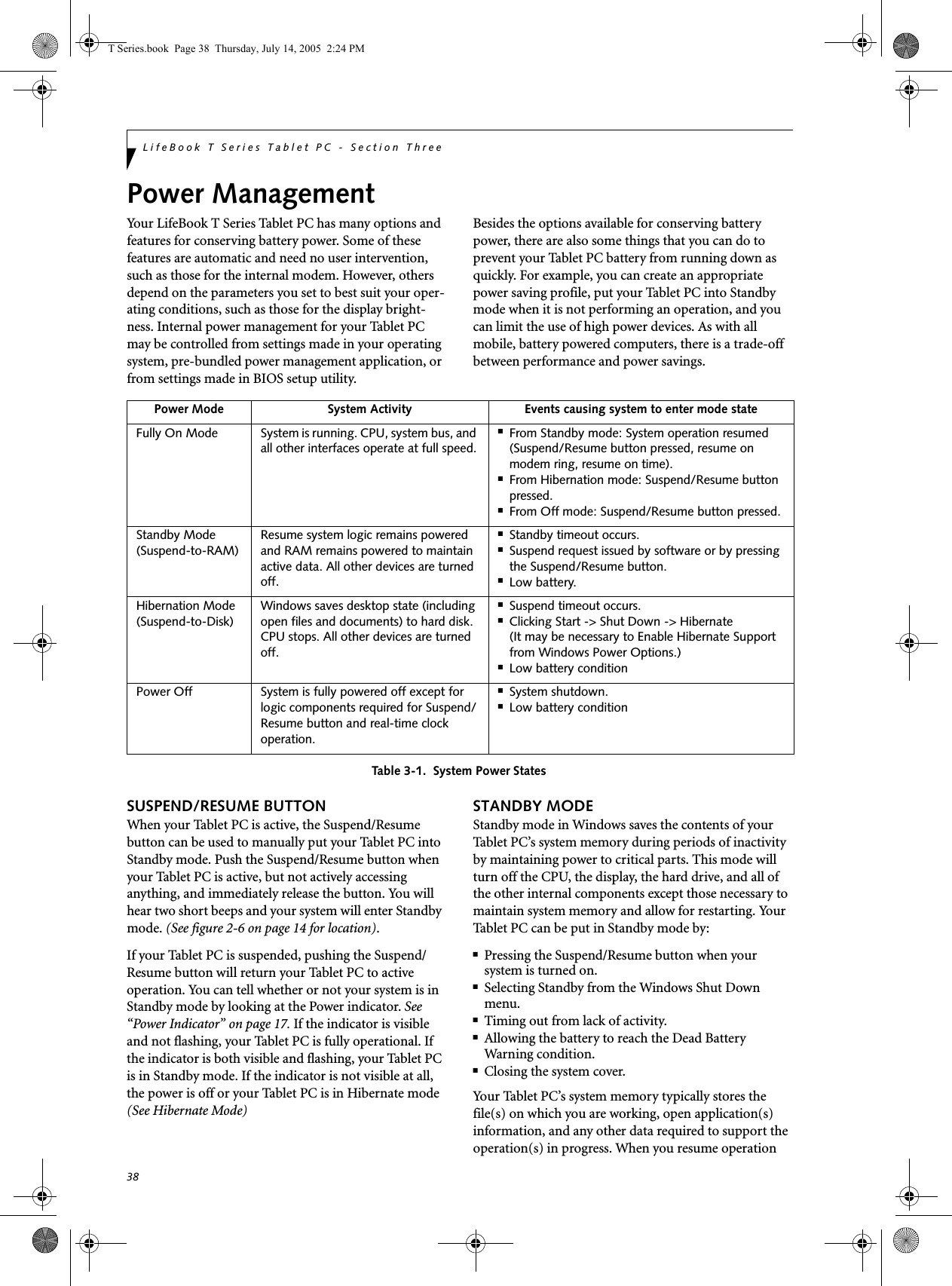
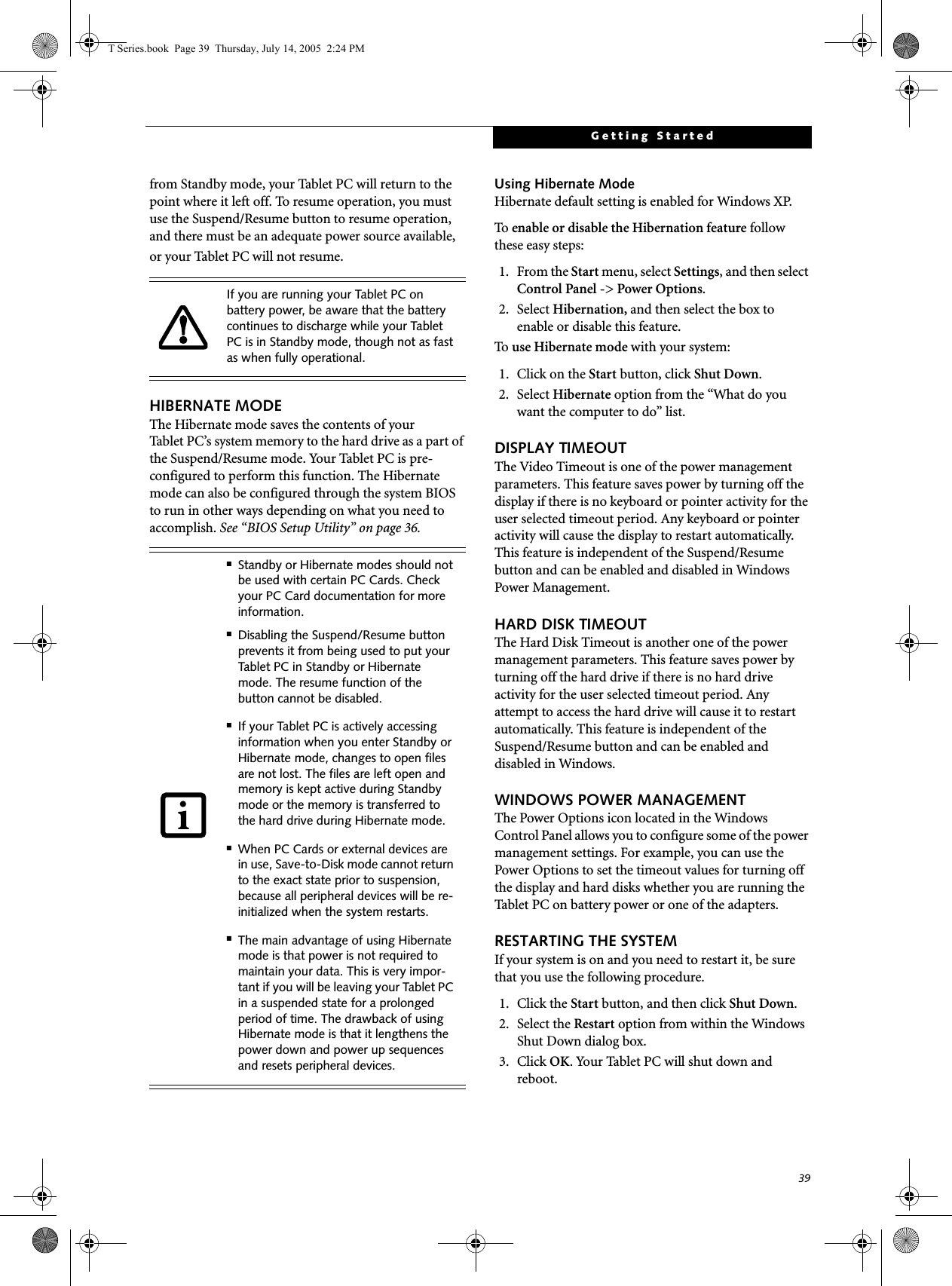

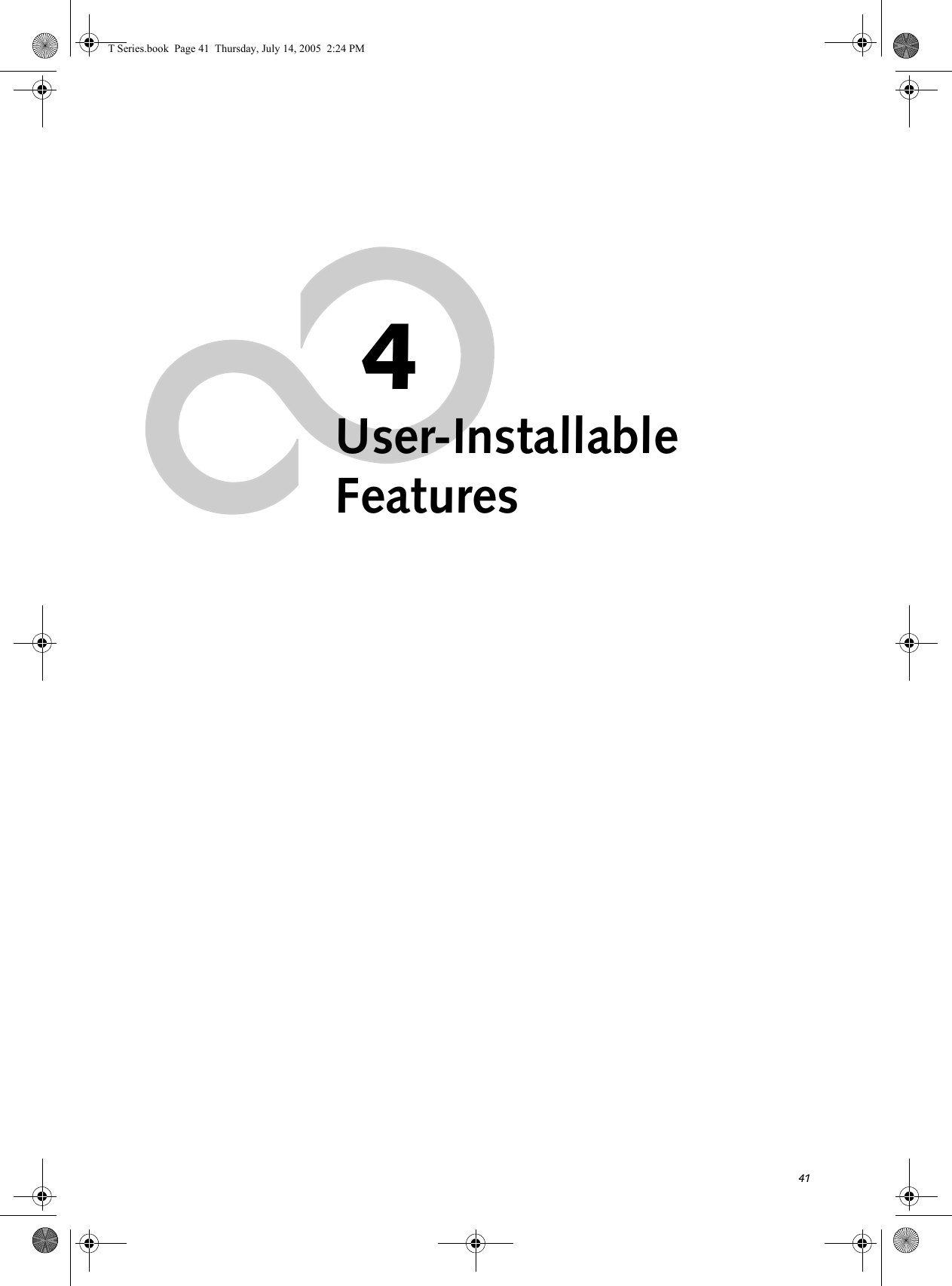


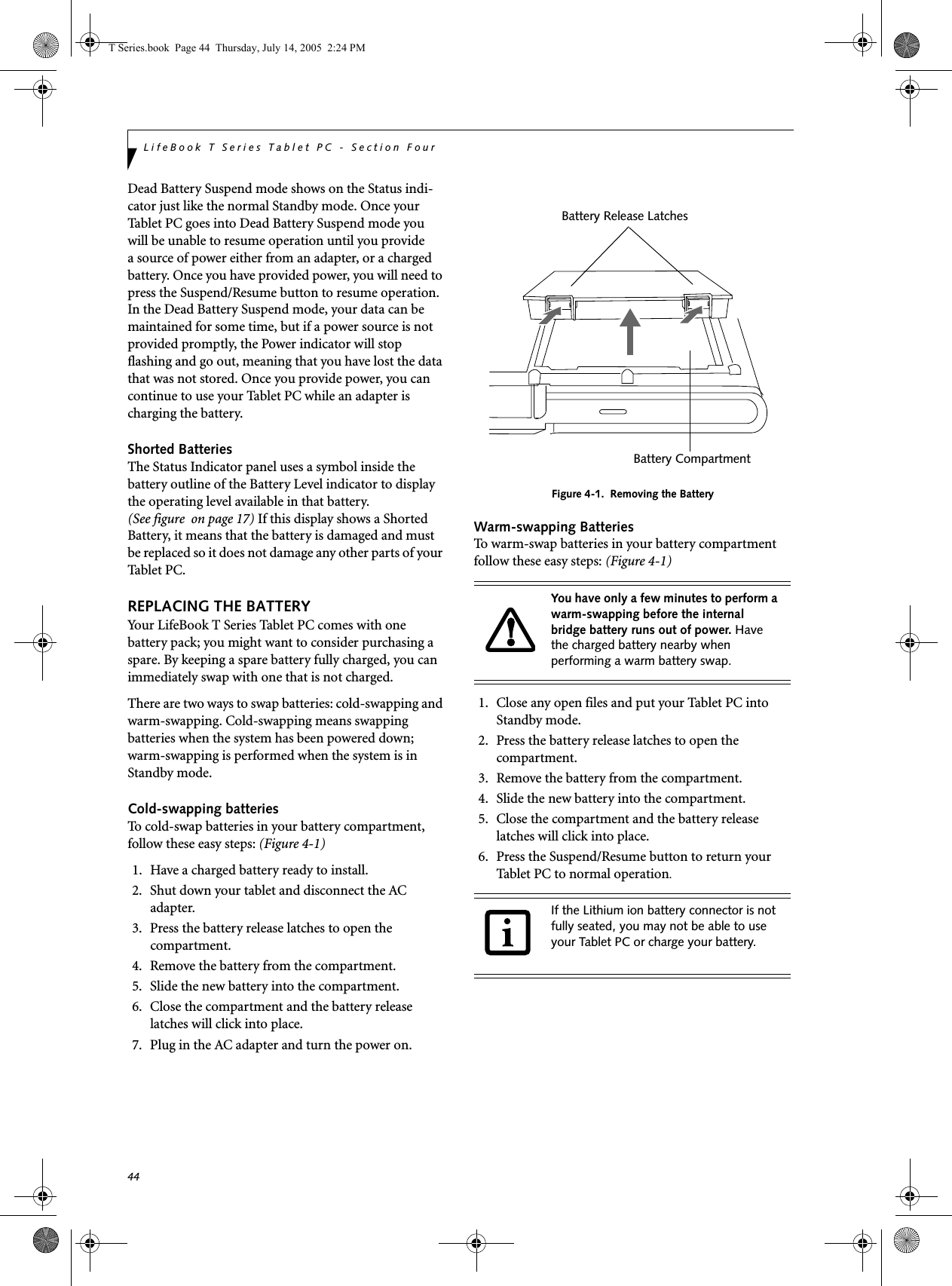

![46LifeBook T Series Tablet PC - Section FourCHECKING THE MEMORY CAPACITYOnce you have changed the system memory capacity by either adding or removing a memory upgrade module, be sure to check that your tablet has recognized the change.You can check the memory capacity by clicking [Start]-> Control Panel, then double-clicking the System icon. Select the General tab and check the amount of memory under “Computer.”The amount of memory displayed should be approxi-mately the total of all memory modules installed. There may be a discrepancy of 8 MB which is allocated for fixed video memory.Your Tablet PC uses Dynamic Video Memory Technology (DVMT), which allows the video driver to dynamically determine the amount of memory that is used. Your Tablet PC can use a maximum of 128 MB of system memory for video functions. If the total memory displayed is incorrect, check that your memory upgrade module is properly installed. (If the module is properly installed and the capacity is still not correctly recognized, see Troubleshooting on page 60.T Series.book Page 46 Thursday, July 14, 2005 2:24 PM](https://usermanual.wiki/Fujitsu-Client-Computing/WB0038.App-I1-User-Manual-part-1/User-Guide-639920-Page-52.png)
![47User-Installable FeaturesFigure 4-6 Flexible BayFlexible Bay DevicesYour Fujitsu Tablet PC contains a Flexible Bay. The Flex-ible Bay can house an optical drive, a Lithium ion battery, or a weight saver. (Figure 4-6)Your Flexible Bay will have one of the following devices installed. ■Modular Dual-Layer Multi-Format DVD Writer: This allows you to access movies, software, and audio DVD/CDs and record to DVD, CD, and DVD-RAM discs.■Modular DVD/CD-RW combo drive: This allows you to access movies, software, and audio DVD/CDs as well as to write to CDs. ■Modular Lithium ion battery: This is a rechargeablebattery that can be used to power your Tablet PC when an adapter is not connected.■Weight Saver: This is used to fill the bay when no device is needed.FUJITSU TABLET CONTROLS - CD/DVD DRIVE HELP The CD/DVD Drive tab of the Fujitsu Tablet Controls utility allows you to enable or disable your DVD drive when the Tablet PC is used in “undocked” (i.e., not connected to a port replicator) tablet mode.Using the Optical Drive Disabling FeatureThe CD/DVD tab of the Fujitsu Tablet Controls window consists of three checkboxes:■Lock CD/DVD drive when the unit is in tablet mode ■Show tray icon when CD/DVD drive is locked. ■Show notification messages when CD/DVD drive is locked/unlocked Lock CD/DVD drive when the unit is in tablet mode:This checkbox should normally be checked (see “Impor-tant Notes” above). If you would like to access the DVD drive while your system is in undocked tablet mode, deselect this checkbox. A message will appear asking if you really want to unlock the drive. Click [OK] to proceed, or [Cancel] to return to the utility.Show tray icon when CD/DVD drive is locked:This checkbox should normally be checked. If you would not like the Fujitsu Tablet Controls icon to appear in the system tray when the drive is locked, clear this box.Show notification messages when CD/DVD drive is locked/unlocked:This checkbox should normally be checked. If you would not like to be prompted when the drive is locked or unlocked, clear this box.Buttons■Click the [OK] button to accept the changes and close the window. ■Click the [Apply] button to accept the changes and leave the window open. ■Click the [Cancel] button to close the window without accepting the change. ■Click the [Help] button to view the help file associated with the selected tab within Fujitsu Tablet Controls. Flexible BayFlexible Bay Eject LeverThe DVD drive in your Tablet PC is designed to work optimally when the system is lying flat on a stable surface. Using the drive while the system is not on a flat surface could result in damage to the drive and/or the media. SUCH DAMAGE IS NOT COVERED UNDER YOUR WARRANTY. You are strongly advised not to use the drive while the system is in undocked tablet mode. This feature is in effect only when the user is logged-in.T Series.book Page 47 Thursday, July 14, 2005 2:24 PM](https://usermanual.wiki/Fujitsu-Client-Computing/WB0038.App-I1-User-Manual-part-1/User-Guide-639920-Page-53.png)
![48LifeBook T Series Tablet PC - Section FourSystem Tray IconWhen your system is in undocked tablet mode, and the “Lock CD/DVD drive when the unit is in tablet mode” box is checked, a Fujitsu Tablet Controls icon will appear at the bottom right of the display. When you select this icon, a menu will appear containing three items:■Unlock CD/DVD Drive for this tablet session ■Configure ■About Unlock CD/DVD Drive for this tablet sessionWhen you click this menu item, you will be asked whether you really want to unlock the drive. To unlock the drive, click [Yes]. Note that enabling the drive in this manner will not change the setting in the Fujitsu Tablet Controls control panel applet.ConfigureWhen you click this menu item, the Fujitsu Tablet Controls window appears.AboutWhen you click About, the help file will open.REMOVING AND INSTALLING MODULAR DEVICES There are two ways to remove and install modular devices in the Flexible Bay:■Cold-swapping: swapping devices while your Tablet PC is powered off.■Hot-swapping: swapping devices while your system is active using the Unplug/Eject icon from your taskbar. Note that if the weight saver is installed rather than a modular device, it is not necessary to use BayManager when removing it.Cold-swappingTo cold-swap modular devices in your Flexible Bay follow these easy steps: (Figure 4-7)1. Close any open files.2. Shut down your Tablet PC.3. Pull out the Flexible Bay eject lever. This will push your device out slightly, allowing you to remove it.4. Slide your device out until it is clear of the bay.This will require light force. Figure 4-7 Removing/Installing a device in the Flexible Bay5. Slide the device you are installing into your tablet until it clicks into place.6. It is now safe to turn your tablet back on.7. You can now access and use the device.Your Tablet PC will automatically detect the new device and activate it within your system. The drive letters asso-ciated with the device will be created and listed under My Computer and Windows Explorer. Hot-swapping Hot-swapping is provided through the Unplug or Eject Hardware utility. The icon for the utility appears on the taskbar. Click on the icon and follow the on-screen instructions.You should never leave your Flexible Bay empty when the tablet is in operation. If left empty, dust or foreign matter may accumulate inside the tablet.Use care when aligning or seating devices in the bay. If the fit is incorrect, you may damage the bay or device. If the device does not move easily in the bay, remove it and check for dirt or foreign objects. It will require a firm push to latch it in place.(a) (b)Flexible Bay Eject Lever(d)(c)T Series.book Page 48 Thursday, July 14, 2005 2:24 PM](https://usermanual.wiki/Fujitsu-Client-Computing/WB0038.App-I1-User-Manual-part-1/User-Guide-639920-Page-54.png)
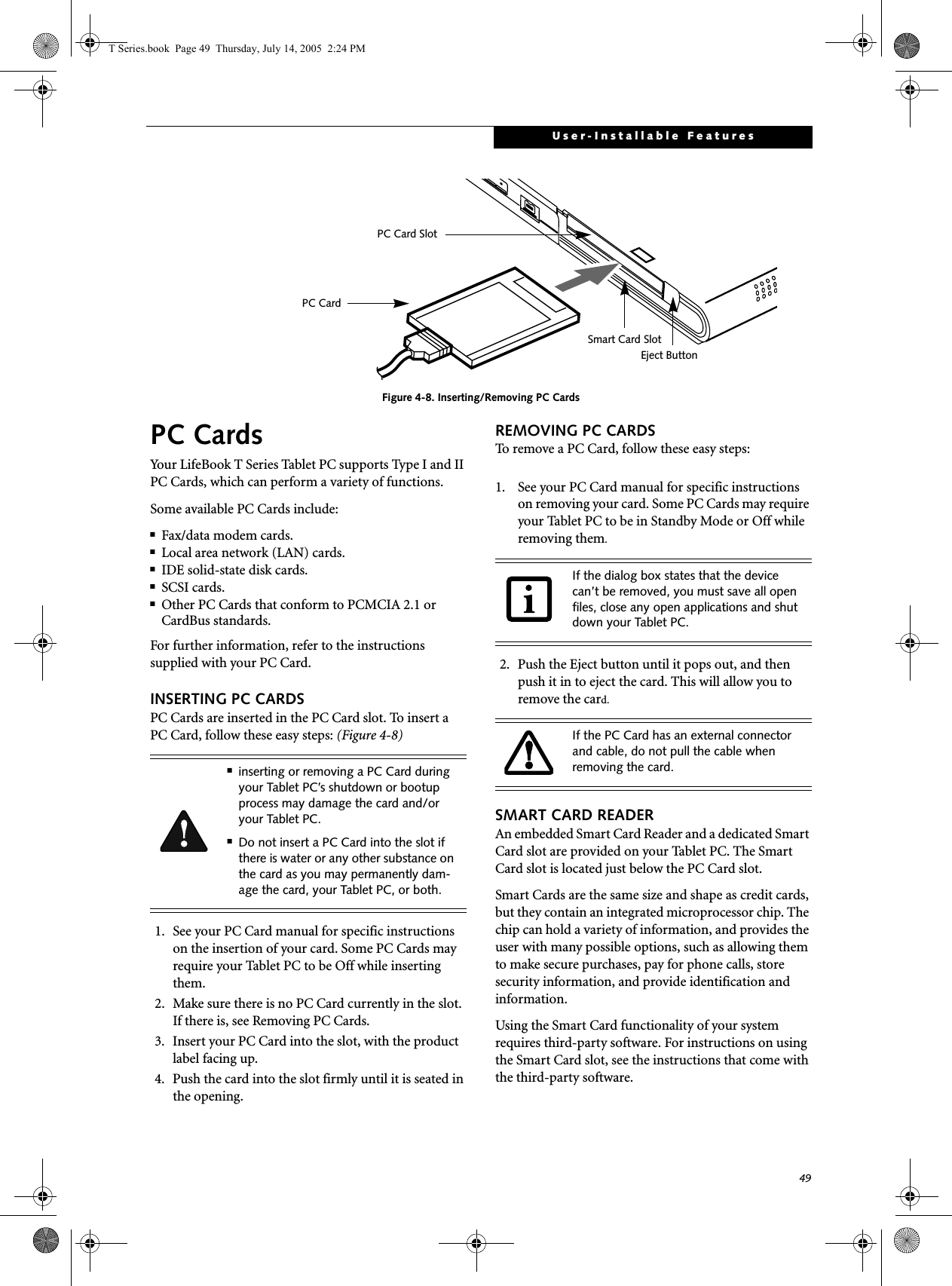
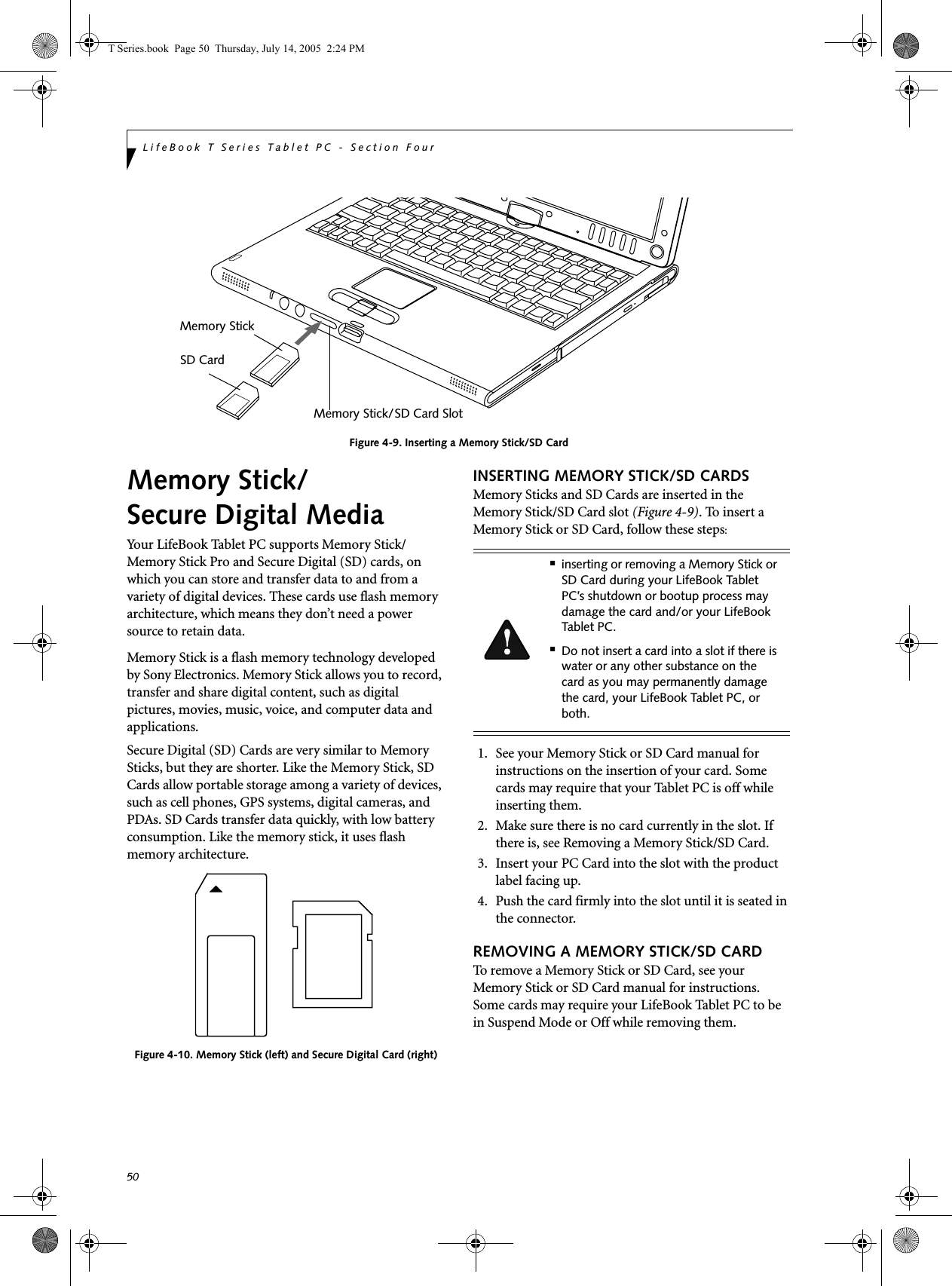

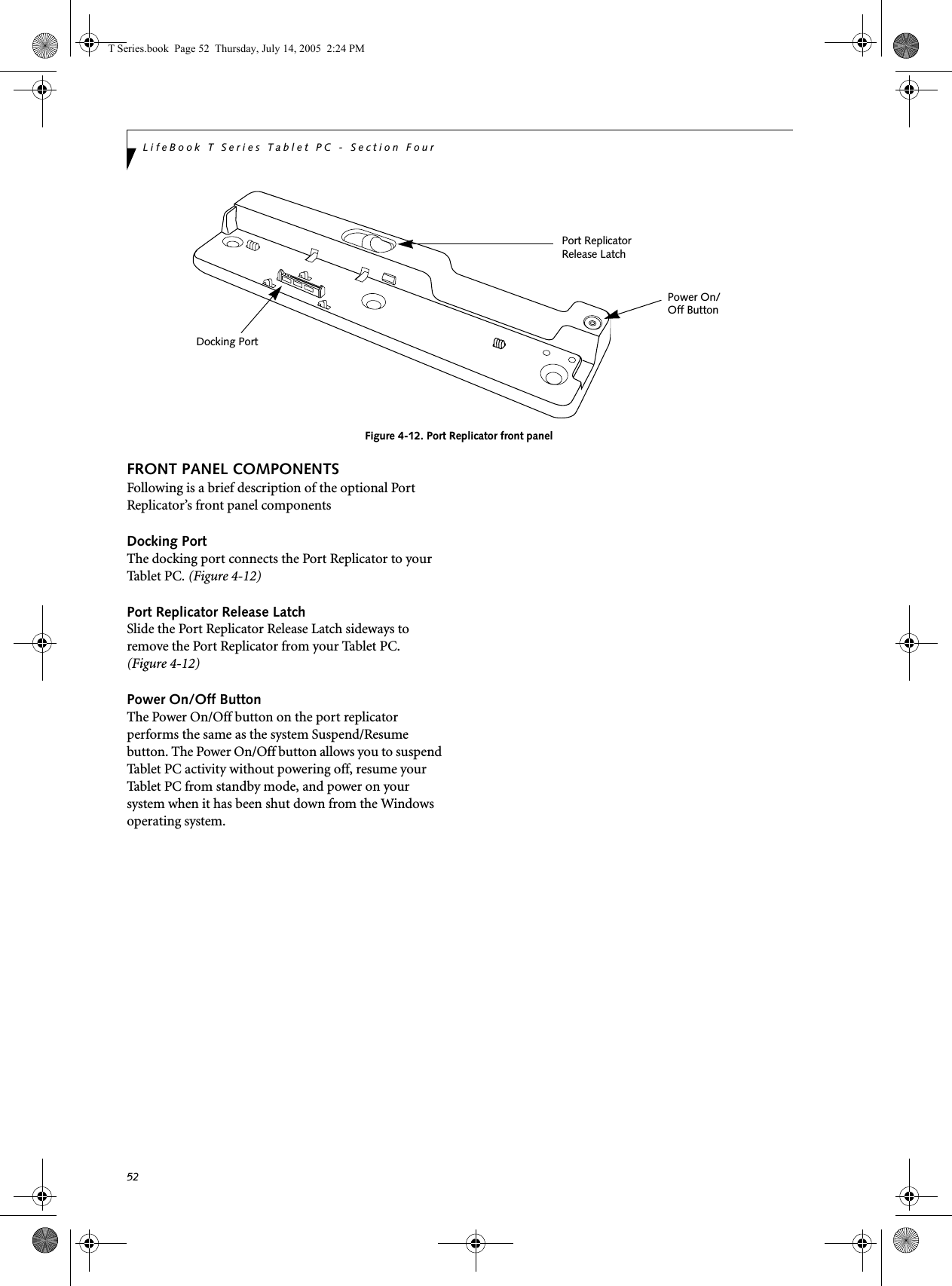
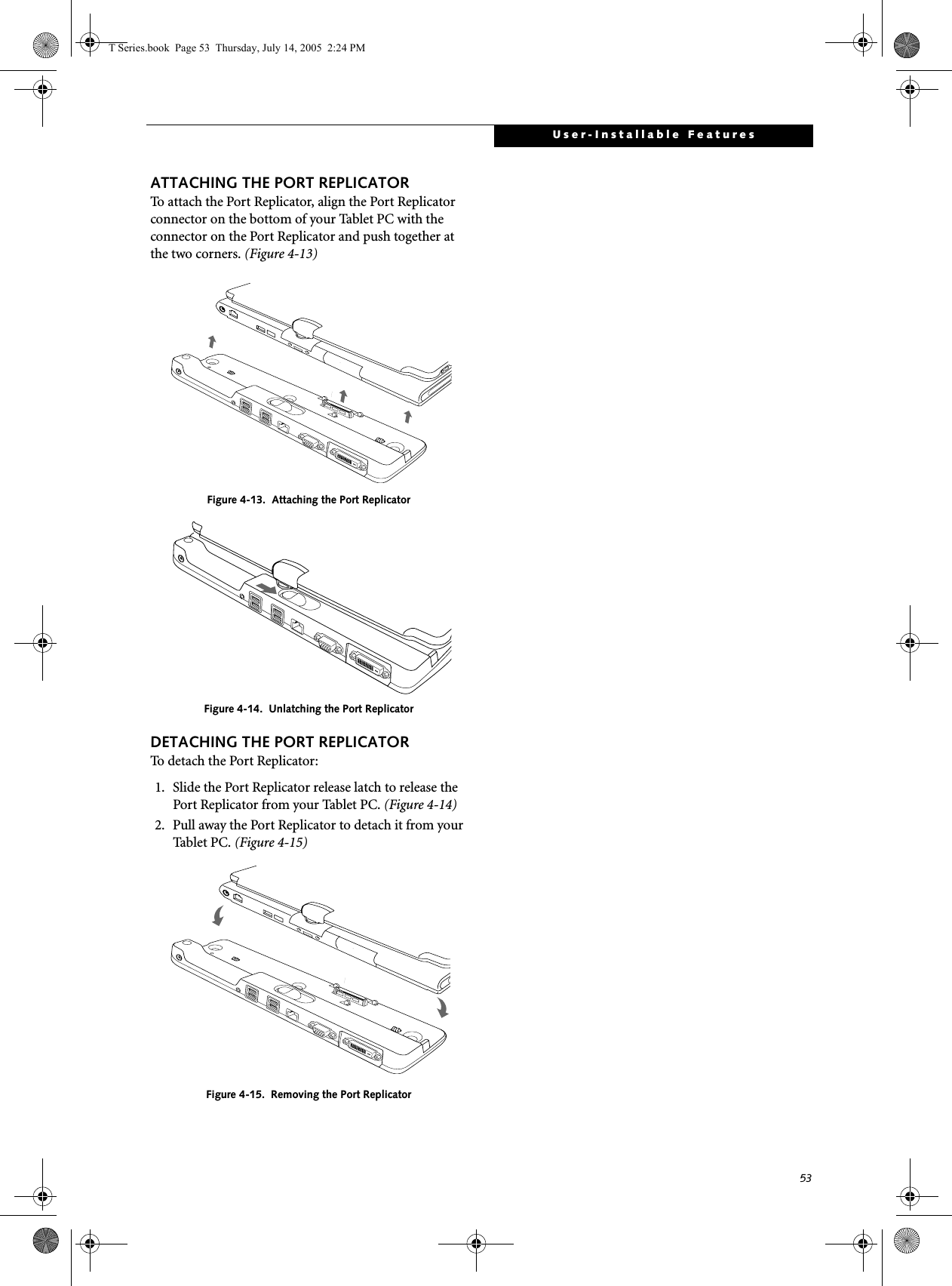
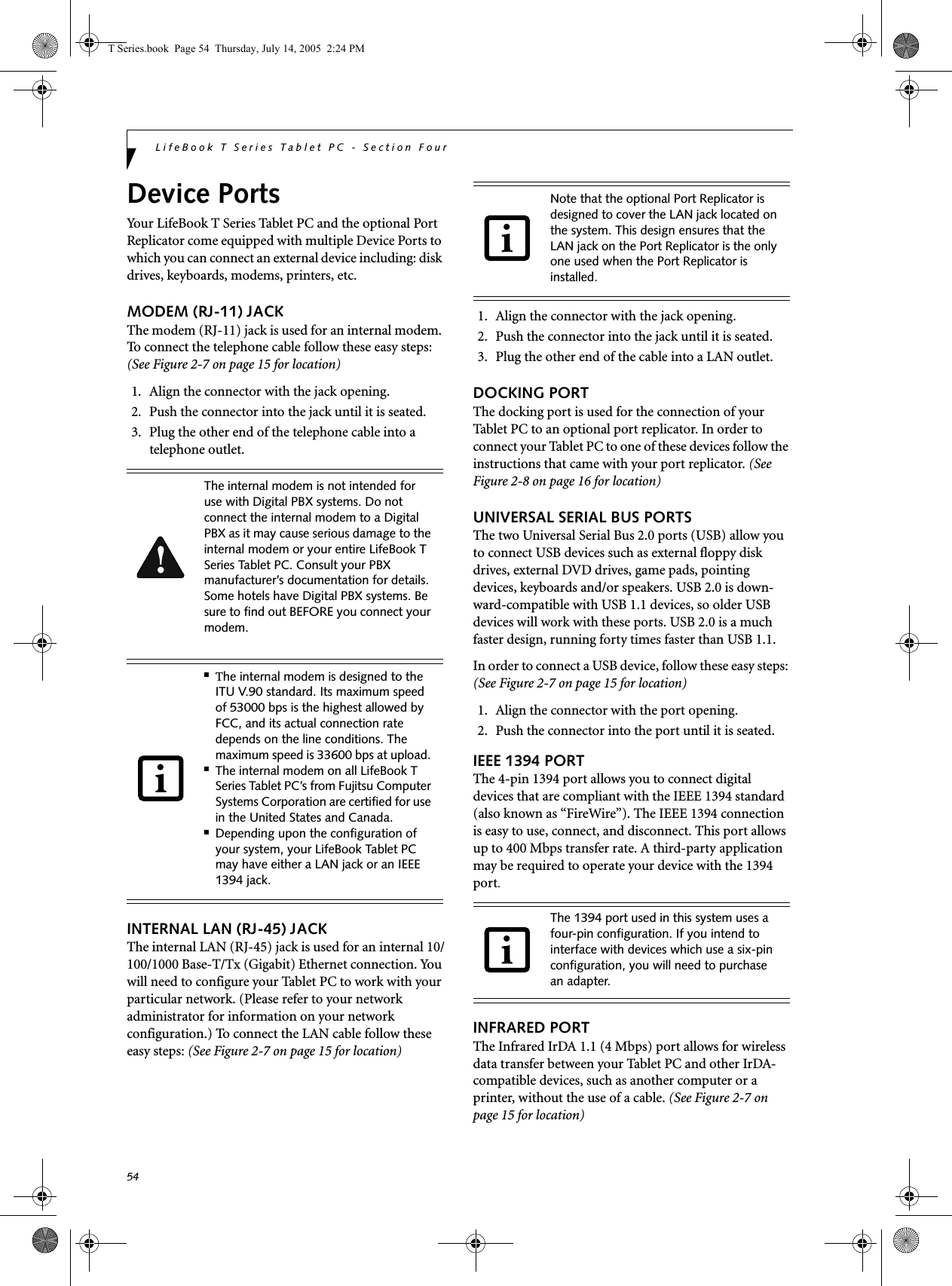
![55User-Installable FeaturesIt is important to keep in mind that while carrying out this form of communication, both devices must be placed so their infrared ports are directly facing each other without obstruction. The devices must also be separated by at least 6" but no more than 36" for maximum performance. The following conditions may interfere with infrared communications:■A television, radio remote control unit, or a wireless headphone is being used nearby.■Direct sunlight, fluorescent light, or incandescent light shines directly on the port.MICROPHONE JACKThe microphone jack allows you to connect an external mono microphone. Your microphone must be equipped with a 1/8”(3.5 mm) mono mini-plug in order to fit into the microphone jack of your Tablet PC. In order to connect a microphone follow these easy steps: (See Figure 2-4 on page 11 for location)1. Align the connector with the port opening.2. Push the connector into the port until it is seated.HEADPHONE JACKThe headphone jack allows you to connect headphones or powered external speakers to your Tablet PC. Your headphones or speakers must be equipped with a 1/8” (3.5 mm) stereo mini-plug. In order to connect head-phones or speakers follow these easy steps: (See Figure 2-4 on page 11 for location)1. Align the connector with the port opening.2. Push the connector into the port until it is seated.EXTERNAL VIDEO PORTThe external video port allows you to connect an external monitor or LCD projector. In order to connect an external monitor follow these easy steps: (See Figure 2-7 on page 15 for location). There is also an external VGA monitor on the port replicator (See Figure 4-11 on page 51 for location). 1. Remove the cover from the port opening, if present.2. Align the connector with the port opening.3. Push the connector into the port until it is seated.4. Tighten the two hold-down screws, located oneach side of the connector. EXTERNAL DVI PORTThe external Digital Video Interface (DVI) port on the optional port replicator allows you to connect an external digital monitor or projector. In order to connect a DVI monitor follow these easy steps: (See Figure 4-11 on page 51 for location). 1. Align the connector with the port opening.2. Push the connector into the port until it is seated.3. Tighten the two hold-down screws, located on each side of the connector.■Do not move either device while com-munication is active as it may interrupt data transmission.■Be careful not to scratch the infrared port lens. Scratches, dirt, or other sur-face marks can degrade operation.If you plug headphones into the headphone jack, the built-in stereo speakers will be disabled.When an external monitor is plugged in, pressing the [Fn] + [F10] keys allows you to change your selection of where to send your display video. Each time you press the key combination, you will step to the next choice, starting with the built-in display panel only, moving to the external monitor only, finally moving to both the built-in display panel and an external monitor.T Series.book Page 55 Thursday, July 14, 2005 2:24 PM](https://usermanual.wiki/Fujitsu-Client-Computing/WB0038.App-I1-User-Manual-part-1/User-Guide-639920-Page-61.png)
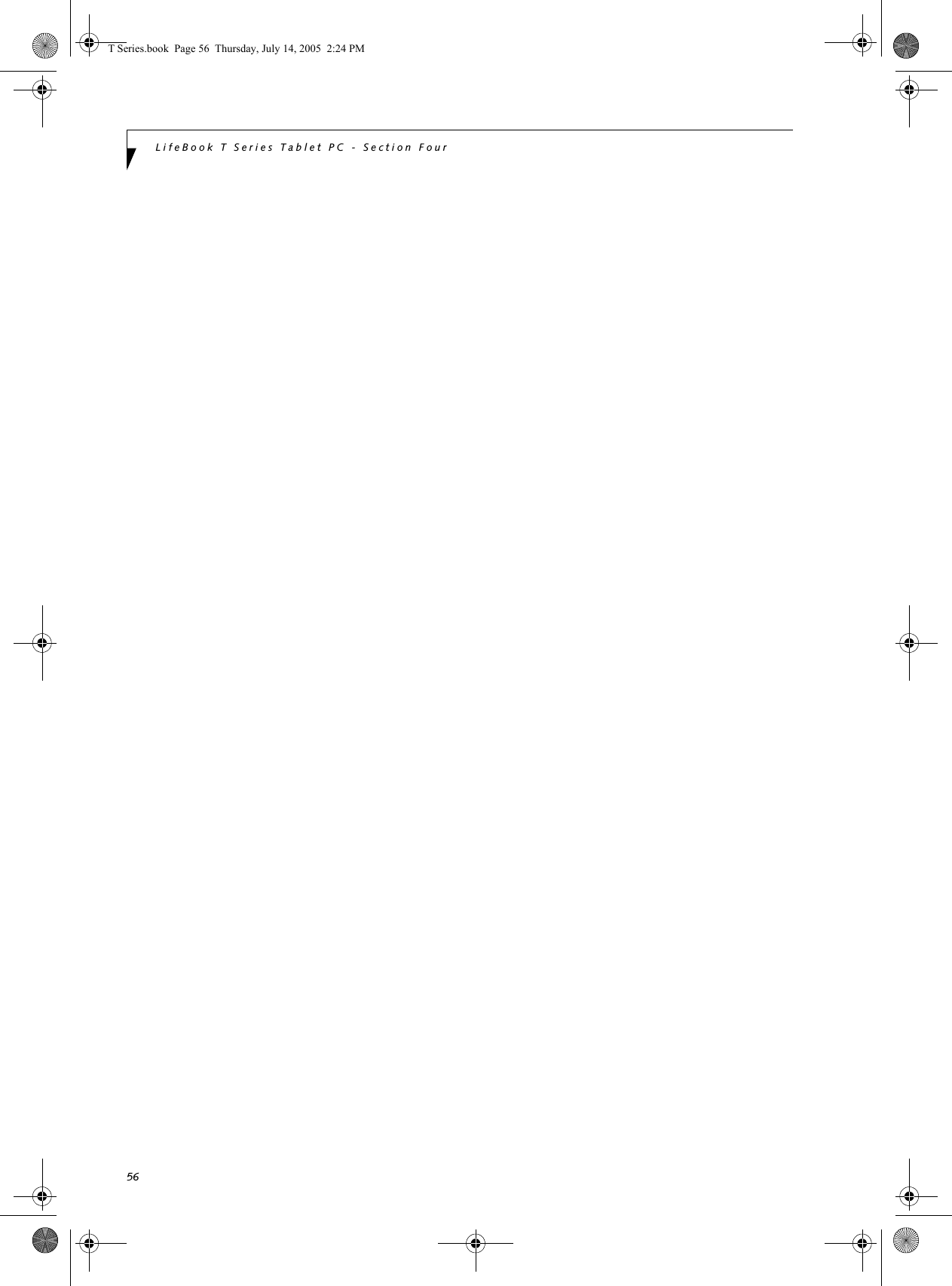

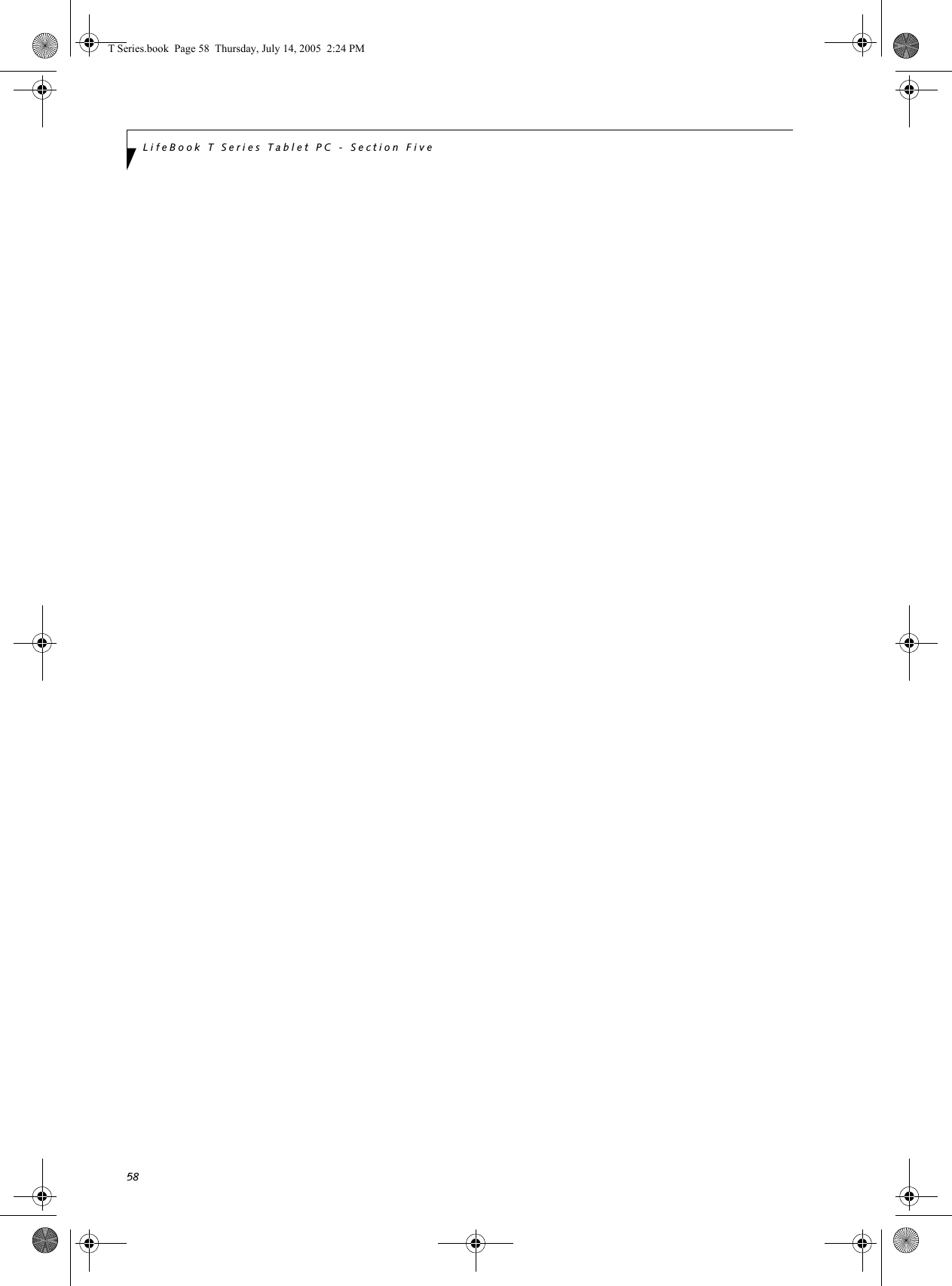
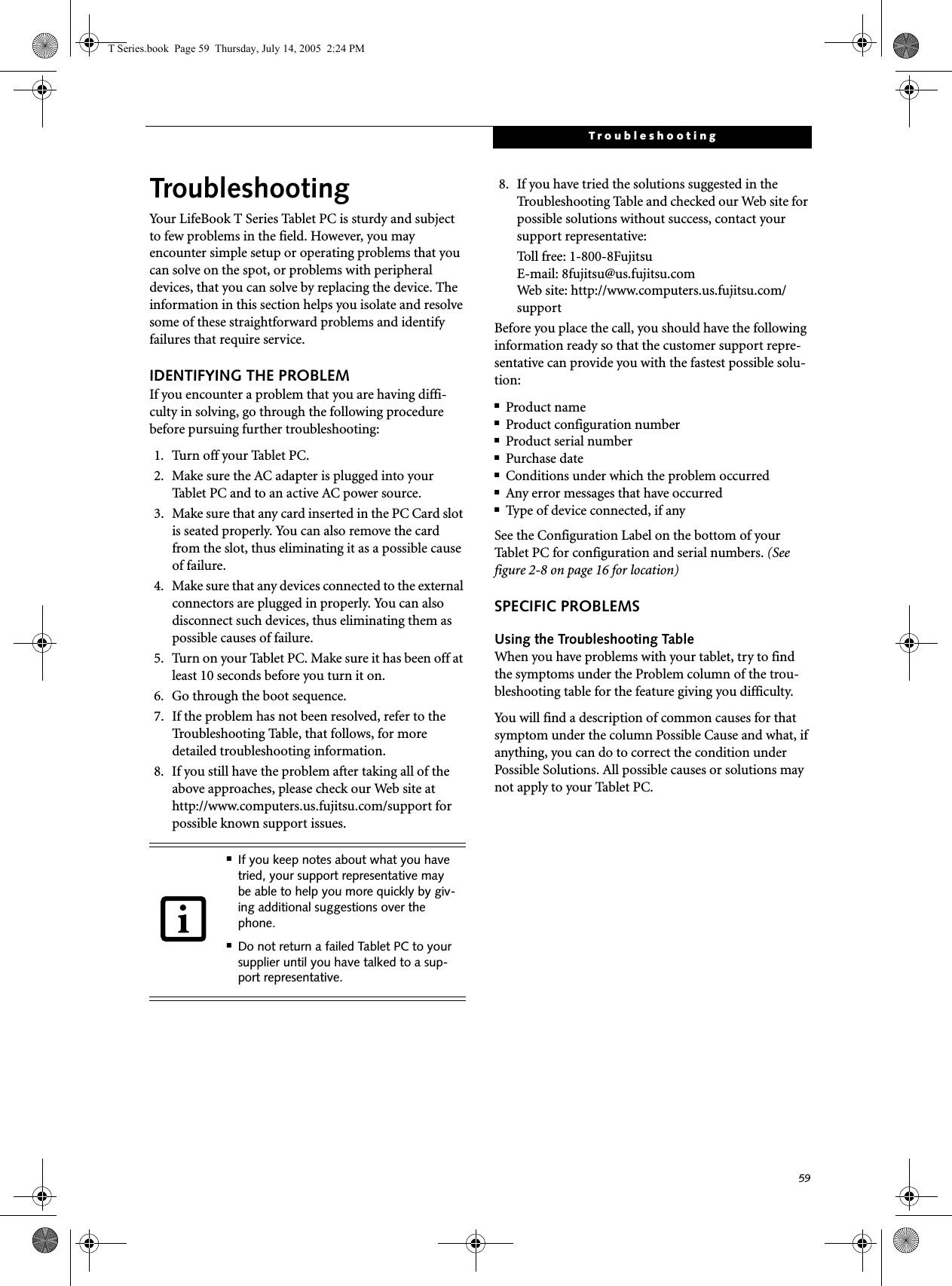
![60LifeBook T Series Tablet PC - Section FiveTROUBLESHOOTING TABLEProblem PageAudio Problems . . . . . . . . . . . . . . . . . . . . . . . . . . page 60Docking Problems . . . . . . . . . . . . . . . . . . . . . . . . page 60Hard Drive Problems . . . . . . . . . . . . . . . . . . . . . . page 60Keyboard or Mouse Problems. . . . . . . . . . . . . . . page 60Pen Input Problems . . . . . . . . . . . . . . . . . . . . . . . page 61Infrared Problems . . . . . . . . . . . . . . . . . . . . . . . . page 61Memory Problems . . . . . . . . . . . . . . . . . . . . . . . . page 61Problem PageModem Problems. . . . . . . . . . . . . . . . . . . . . . . . . page 61USB Device Problems . . . . . . . . . . . . . . . . . . . . . page 62PC Card Problems . . . . . . . . . . . . . . . . . . . . . . . . page 62Power Failures . . . . . . . . . . . . . . . . . . . . . . . . . . . page 62Shutdown and Startup Problems . . . . . . . . . . . . page 64Video Problems . . . . . . . . . . . . . . . . . . . . . . . . . . page 65Miscellaneous Problems . . . . . . . . . . . . . . . . . . . page 66Problem Possible Cause Possible SolutionsAudio ProblemsThere is no sound coming from the built-in speakers.The software volume control is set too low.Adjust the sound volume control settings in your software, operating system and applications.Headphones are plugged into your Tablet PC.Plugging in headphones disables the built-in speakers, remove the headphones.Software driver is not config-ured correctly.Refer to your application and operating system documentation for help.Sound could have been muted with function keys.Press [F3] while holding the [Fn] key to toggle the sound on and off.Port Replicator ProblemsTablet PC does not turn on when installed in optional Port ReplicatorPort Replicator AC adapter is not plugged in. Provide power to the Port Replicator.Tablet PC is not properly seated in the Port Replicator.Remove and re-dock your Tablet PC.Hard Drive ProblemsYou cannot access your hard drive.The setup utility is incorrectly set for your internal (Primary Master) hard drive.Revise BIOS settings to set the Primary Mastercorrectly. See “BIOS Setup Utility” on page 36.The wrong drive designator was used by an application when a bootable CD-ROM was used to start the Tablet PC.Verify drive designator used by application is inuse by the operating system. When the operating system is booted from a CD, drive designationsare automatically adjusted. Security is set so your oper-ating system cannot be started without a password.Verify your password and security settings.Keyboard or Mouse ProblemsThe built-in keyboard does not seem to work.The Tablet PC has gone into Standby mode.Push the Suspend/Resume button.Your application has locked out your keyboard.Try to use your integrated pointing device to restart your system. If this fails, turn your Tablet PC off by pressing the suspend/resume button for 10 seconds or more, and then turn it back on.The NumLock key has been toggled on.Press the NumLock key to toggle it off.T Series.book Page 60 Thursday, July 14, 2005 2:24 PM](https://usermanual.wiki/Fujitsu-Client-Computing/WB0038.App-I1-User-Manual-part-1/User-Guide-639920-Page-66.png)
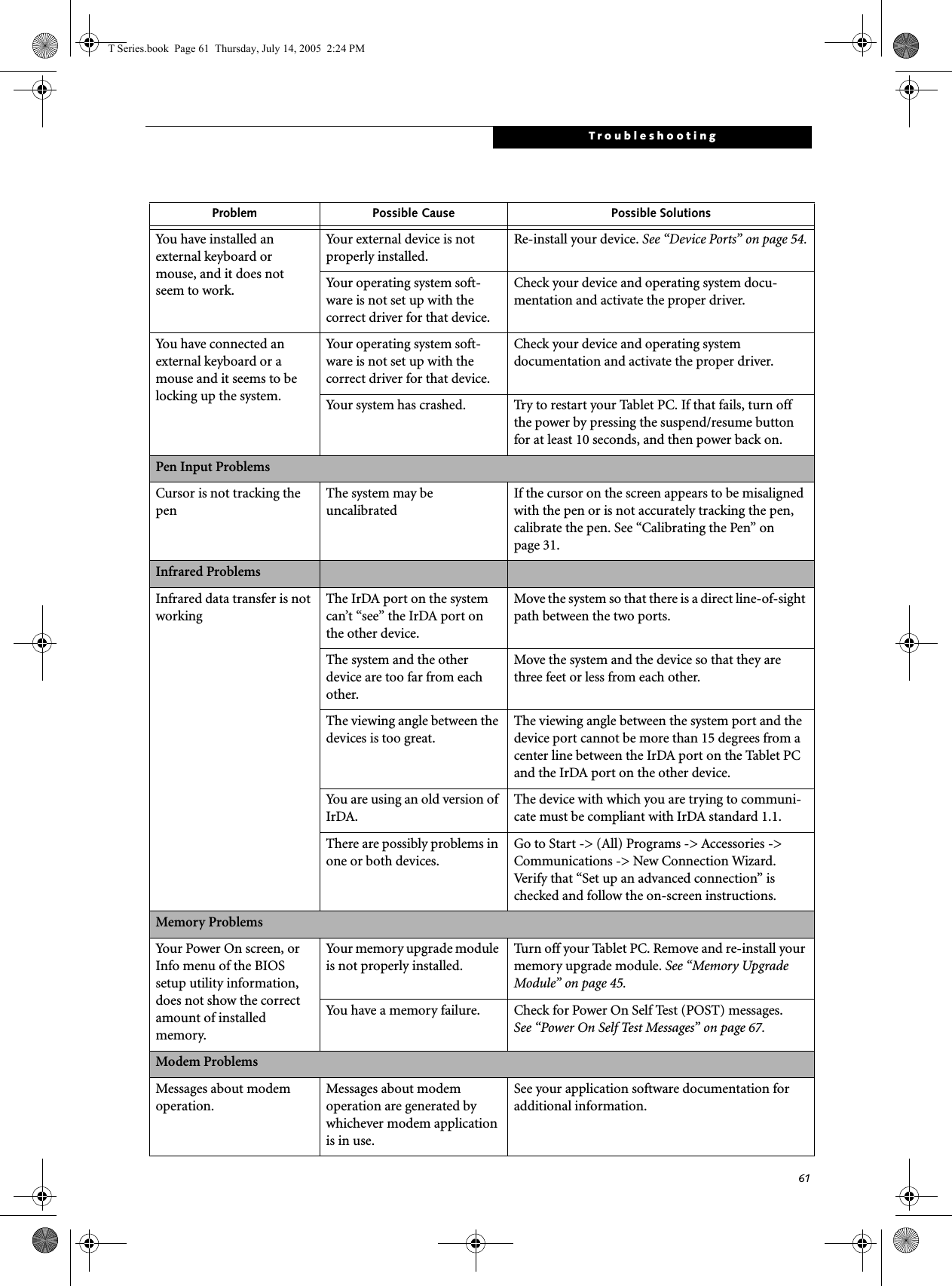
![62LifeBook T Series Tablet PC - Section FiveModem does not appear to work.Modem may not have been initialized.Verify that the modem has been initialized by the operating system. TO do so, right-click on My Computer and select the Hardware tab. Click [Device Manager] and click on the “+” symbol that appears next to Modems. Verify that your device is listed as installed.USB Device ProblemsYou have installed a USB device, but your Tablet PC does not recognize the device, or the device does not seem to work properly.The device is not properly installed.Remove and re-install the device. See “Device Ports” on page 54.The device may have been installed while an application was running, so your Tablet PC is not aware of its installation.Close the application and restart your Tablet PC.Your software may not have the correct software driver active.See your software documentation and activate the correct driver.Your device and another device are assigned the same I/O address.Check all I/O addresses located within the BIOS setup utility and any other installed hardware or software to make sure there are no duplications.PC Card ProblemsA card inserted in the PC Card slot does not work or is locking up the system.The card is not properly inserted.Remove and re-insert the card. See “PC Cards” on page 49.The card may have been inserted while an application was running, so your Tablet PC is not aware of its insertion.Close the application and restart your Tablet PC.Your software may not have the correct software driver active.See your software documentation and activate the correct driver.Your PC Card device and another device are assigned the same I/O address.Check all I/O addresses located within the BIOS setup utility and any other installed hardware or software to make sure there are no duplications.Power FailuresYou turn on your Tablet PC and nothing seems to happen.The installed battery is completely discharged or there is no power adapter (AC or Auto/Airline) installed.Check the Status Indicator Panel to determine the presence and condition of the battery. See “Status Indicator Panel” on page 17. Install a charged battery or a Power adapter.The battery is installed but is faulty.Use the Status Indicator Panel to verify the presence and condition of the battery. See “Status Indicator Panel” on page 17. If a battery is indicating a short, remove that battery and operate from another power source or replace that battery.Problem Possible Cause Possible SolutionsT Series.book Page 62 Thursday, July 14, 2005 2:24 PM](https://usermanual.wiki/Fujitsu-Client-Computing/WB0038.App-I1-User-Manual-part-1/User-Guide-639920-Page-68.png)
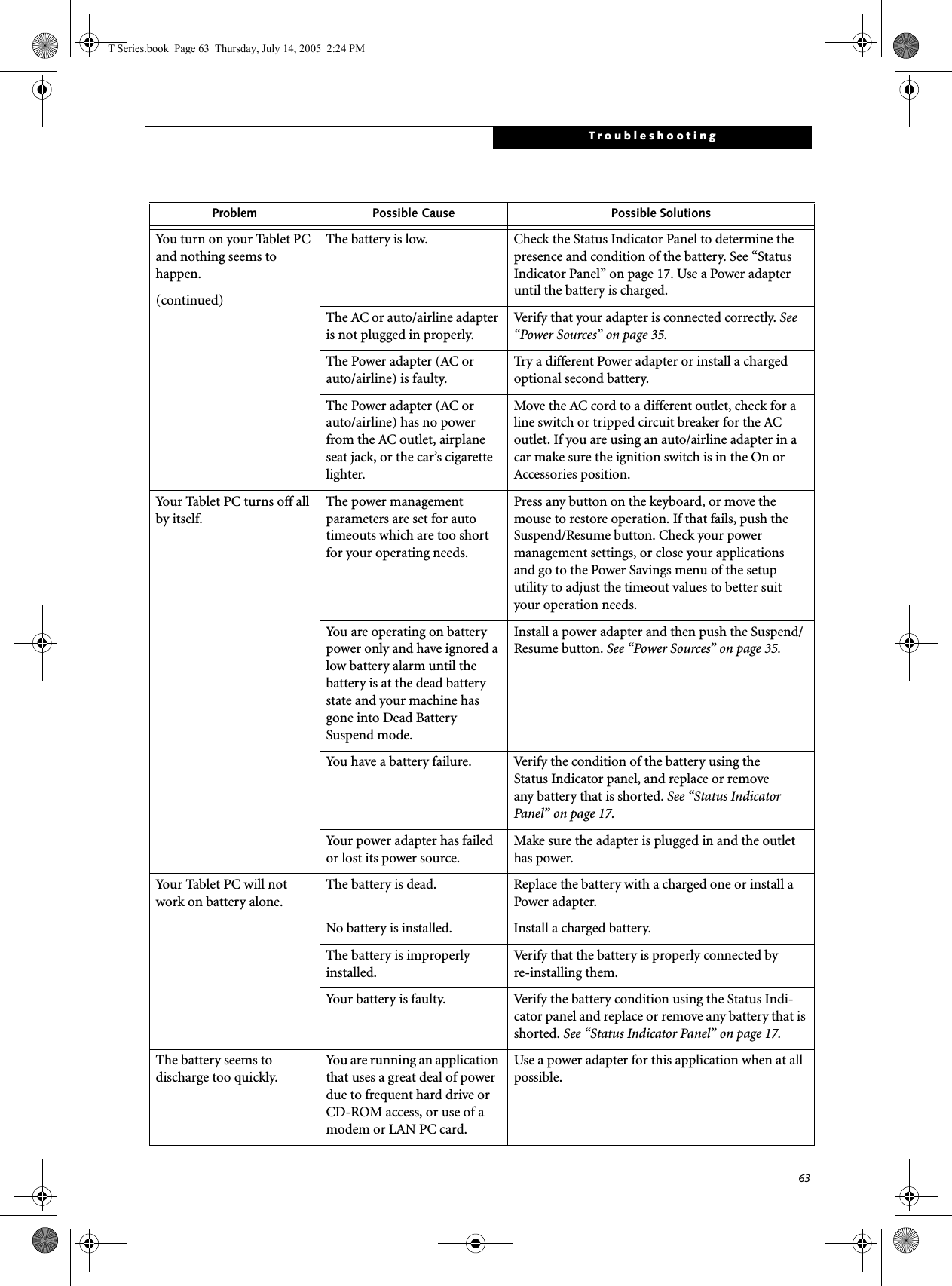
![64LifeBook T Series Tablet PC - Section FiveThe battery seems to discharge too quickly.(continued)The power savings features may be disabled.Check the power management and/or setup utility settings in the Power Savings menu and adjust according to your operating needs.The brightness is turned all the way up.Turn down the brightness adjustment. The higher the brightness the more power your display uses.The battery is very old. Replace the battery.The battery has been exposed to high temperatures.Replace the battery.The battery is too hot or too cold. Restore the Tablet PC to normal operating tempera-ture. The Charging icon on the Status Indicator panel will flash when the battery is outside itsoperating range.The AC Adapter is defective. Replace with another AC Adapter to see if the problem persists. Replace any defective AC Adapters.Shutdown and Startup ProblemsThe Suspend/Resume button does not work.The Suspend/Resume button is disabled from the Advanced submenu of the Power menu of the setup utility. Enable the button from the setup utility.You did not hold the button in long enough.Hold the button longer. This may need to be a few seconds if your application is preventing the CPU from checking for button pushes.There may be a conflict with the application software.Close all applications and try the button again.The system powers up, and displays power-on information, but fails to load the operating system.The boot sequence settings of the setup utility are not compatible with your configuration.Set the operating source by pressing the [F2] key while the Fujitsu logo is on screen, entering the setup utility and adjusting the source settings from the Boot menu. See “BIOS Setup Utility” on page 36.You have a secured system requiring a password to load your operating system.Make sure you have the right password. Enter the setup utility and verify the Security settings and modify them as accordingly. See “BIOS Setup Utility” on page 36.An error message is displayed on the screen during the Tablet PC boot sequence.Power On Self Test (POST) has detected a problem.See the Power On Self Test (POST) messages to determine the meaning and severity of the problem. Not all messages are errors; some are simply status indicators. See “Power On Self Test Messages” on page 67.Your system display won’t turn on when the system is turned on or when the system has resumed.The system may be password-protected.Check the status indicator panel to verify that the Security icon is blinking. If it is blinking, enter your password.Problem Possible Cause Possible SolutionsT Series.book Page 64 Thursday, July 14, 2005 2:24 PM](https://usermanual.wiki/Fujitsu-Client-Computing/WB0038.App-I1-User-Manual-part-1/User-Guide-639920-Page-70.png)